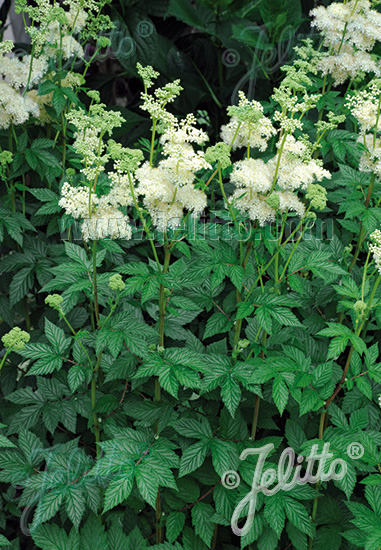Seeds for plants use in Folk Medicine
Featuring unusual folk medicine plant seeds for Universities, Research Facilities, Herbalists and Gardeners.
Our seeds are fresh and ready for delivery.
The information listed with the seeds is for general information only and does not reflect any recommendations on the part of this business. Before using any medicinal plant, we strongly recommend you first consult a physician. Our information is based on published works dealing with herb plants, not medical publications. We shall in no way be held responsible for the actions of anyone using our seeds. Our sole responsibility/liability will be to replace seeds that do not germinate. We shall in no way be liable for the use/misuse of these seeds.
Terms:
Herb: Any plant used for making medicine, seasoning or scents.
Infusion: A tea made by pouring boiling water over the plant or parts of the plant. The most common method of preparing an infusion is to place herbs in a heat tolerant container that has a lid, and pour boiling water over the herbs ( a normal rule of thumb is to use a cup of green herbs per cup of boiling water applied, or a handful of dry herbs per cup of boiling water applied ). Cover the container and allow the herbs to steep in covered container for about 15 minutes. Your infusion is now ready to enjoy!
Decoction: A drink made by boiling the plant or parts of the plant in water and then straining. As a rule of thumb, place the herbs in water that has been brought to a boil, then reduce heat until the water is gently simmering. Simmer for about 15 minutes, then strain. The liquid is the decoction. Honey or an aromatic herb is usually added to improve the taste.
Aromatic. This refers to herbs that have a pleasant smell or taste. They are often used for potpourri or for adding to other herbs to improve the taste of a decoction. One part aromatic to three parts medicinal herb is usually sufficient.
Demulcent: An herb that possesses soothing, mucilaginous qualities which help to relieve any internal irritation such as arrowroot, coltsfoot, comfrey, sassafras pith, and slippery elm.
Liniment: A liniment is a topical solution applied to the skin.
How to make a liniment: You will need a clean glass jar with lid, a pint size canning jar works fine, a cup of chopped fresh herbs from your garden or ¼ cup of dried herbs ( we recommend our tincture packs ) 1/2 pint of grain alcohol ( such as Everclear ) and 1/2 pint of distilled water.
Place the herb material into the jar and fill jar with equal parts grain alcohol and distilled water. Close lid tightly and label the jar with the ingredients and the date.
Store the jar in a dark, dry and cool place. Every 2 days, shake the jar vigorously.
After four to six weeks, strain the mixture through a screen or colander, catching the liquid in bowl, then take the herbs and wrap in a towel or pillowcase and squeeze as much liquid as possible from herbs, catching this liquid in the bowl as well.
The Strained liquid is your finished liniment. We recommend storing liniments in four ounce amber glass bottles. Be sure to label bottles correctly!
Herbal Lozenges: Herbal lozenges are a wonderful way to soothe a sore throat or relieve cold and flu conditions.
How to make Herbal Lozenges: You will need about 4 ounces of your favorite herbal decoction, we recommend Blue Vervain, Echinacea or Sage.
Pour decoction into a bowl and add powdered Marsh Mallow root until you have a thick, paste like solution. Add 3-4 drops of peppermint essential oil to mix.
Make small lozenges by pinching small amounts of the mix between your fingers and shaping to size. Place lozenges on wax paper and allow to dry for a few hours, then store in covered container in refrigerator.
Lozenges should keep in the fridge for several weeks.
Suck on a lozenge whenever you have a sore throat.
Tincture: A preparation made by soaking an herb in alcohol until the alcohol absorbs the beneficial ingredients of the plant. This process is known as maceration.
How to make a tincture: You will need a clean glass jar with lid, a pint size canning jar works fine, a cup of chopped fresh herbs from your garden or ¼ cup of dried herbs ( we recommend our tincture packs ) and 1 pint of vodka. The vodka is usually about 80-85 proof, do not use 100 proof vodka.
Place the herb material into the jar and fill jar with vodka. Close lid tightly and label the jar with the ingredients and the date.
Store the jar in a dark, dry and cool place. Every 2 days, shake the jar vigorously.
After four to six weeks, strain the mixture through a screen or colander, catching the liquid in bowl, then take the herbs and wrap in a towel or pillowcase and squeeze as much liquid as possible from herbs, catching this liquid in the bowl as well.
The Strained liquid is your finished tincture. We recommend storing tinctures in four ounce amber glass bottles, and keeping smaller one ounce amber glass bottles with droppers in your medicine cabinet, re-filling the smaller bottles as needed. Be sure to label bottles correctly!
Tinctures made from at least 25% alcohol ( 80 proof vodka is 40% ) can be stored indefinitely, tinctures you do not use can be passed on to your children and grandchildren.
Compresses and Poultices: A compress is basically a cloth soaked in herbal decoction or infusion that is applied to painful areas. Use Comfrey for sports type injuries, Plantain for insect bits and bee stings, St. John's Wort and Rosemary for pain relief and Chamomile for cramp relief. A poultice is made by placing a cup of the chosen herb in a heat tolerant bowl, pouring boiling water over the herbs and allowing to steep until the herbs have cooled enough to be tolerated by the skin.
Place a clean cotton cloth over the infected area, then place the warm/semi hot herbs on top of the cloth and cover with another piece of cotton cloth. Keep the poultice in place until the herbs have cooled down completely. Discard the herbs and wash the poultice cloths before reusing. Best results are obtained when poultices are applied 3 times a day.
Suppositories and Boluses
You can make a natural suppository using powdered herbs and cocoa butter. To make a suppository should warm cocoa butter to a liquid state in a double boiler and stir in the powdered herbs as it cools. When it is mixed well put into the refrigerator to harden. Roll this out to be about 3/4 of an inch thick. Cut into 3/4 of an inch strips. These are used in the rectum and the vagina to treat infections and irritations. They can also be used for tumors in these areas.
Generally the herbs used in suppositories are astringents such as white oak bark or bayberry bark; and demulcent healing herbs like comfrey root or slippery elm; and antibiotic herbs like garlic and Goldenseal. Goldenseal is really a great one for this as it combines astringent, tissue healing, and antibiotic qualities all in one.
Do not use more than 6 suppositories in a day, or for more than a week at a time. If condition has not cleared up in this time, you should consult your physician.
Our List of Seeds
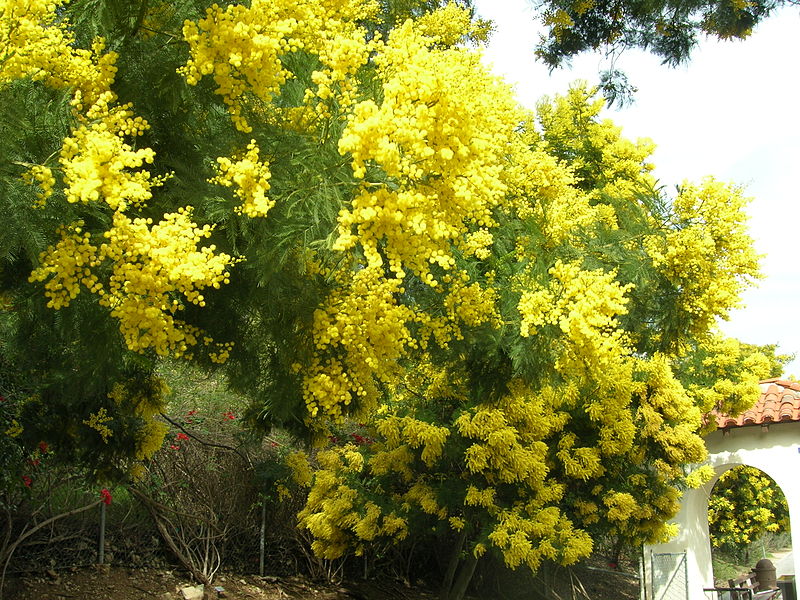
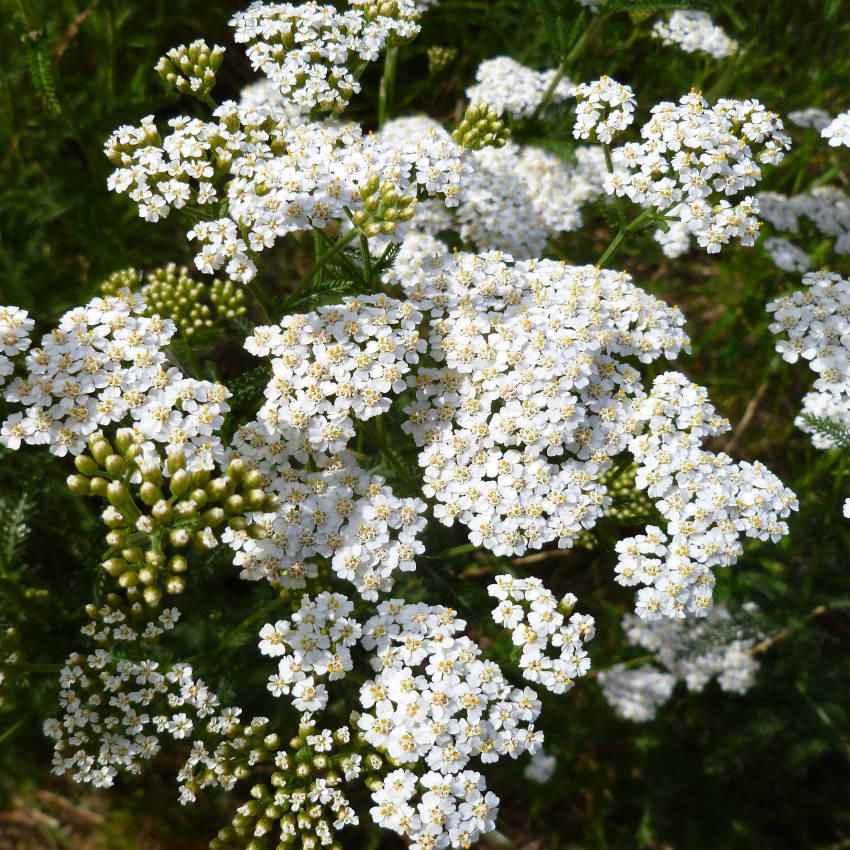
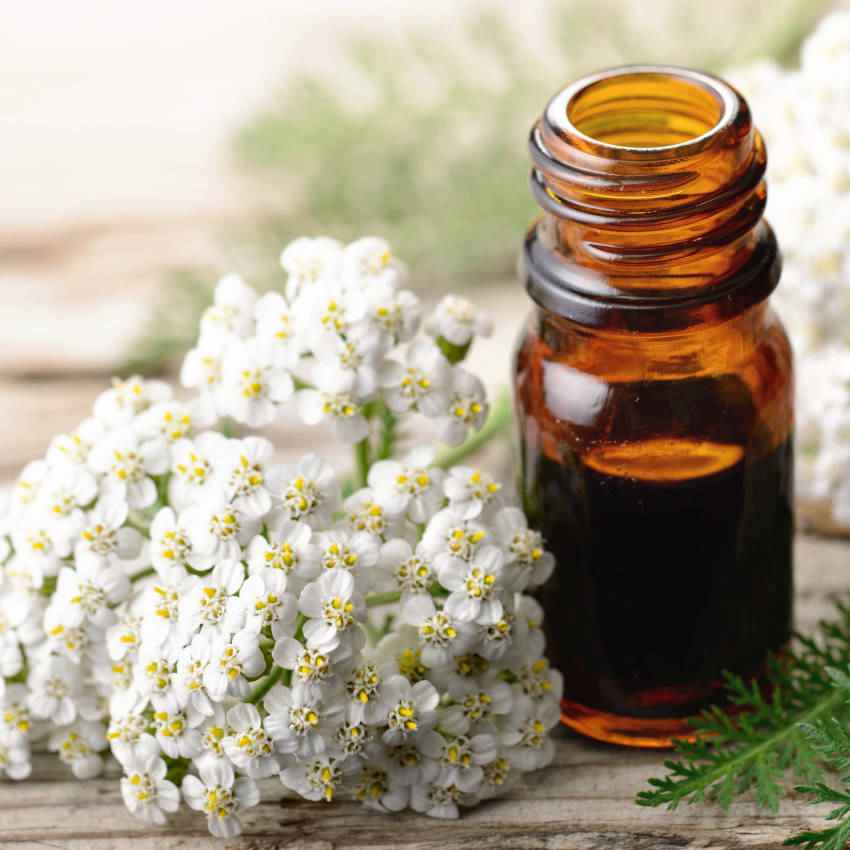
Yarrow or milfoil is a leading backyard medicine plant. A ready first-aid treatment for wounds and nosebleeds, it has larger uses as a circulatory system remedy that both stops bleeding and moves stagnant blood, preventing and clearing blood clots. It tones the blood vessels and lowers high blood pressure. Yarrow is beneficial for a wide range of menstrual problems, and is a first-rate fever herb, used as a hot tea to induce sweating.
Yarrow is a famous wound and fever herb, yet today it can pass unnoticed except as a lawn weed. The legendary Achilles used yarrow as a field dressing for his soldiers’ wounds in the Trojan War, and the plant is named for him.
It's many uses include herbal plant, cottage gardens, wild gardens, meadows, prairies and naturalized areas. Good fresh cut or dried flower.
A perennial growing 24-36" tall, hardy for zones 3-9.
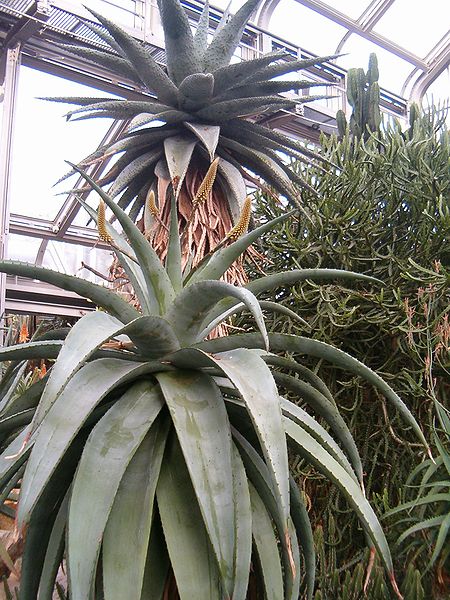
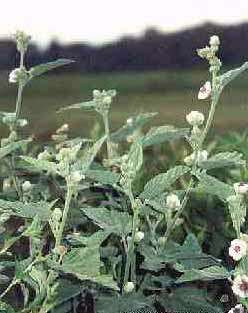
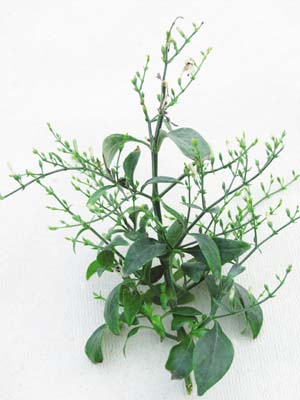
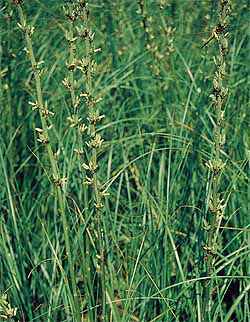
A perennial for zones 2-7.
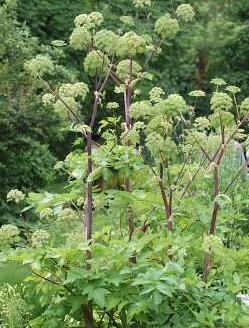
Angelica will grow to a height o 4-6 ft. and prefers partial shade and a moist, slightly acidic soil.
Parts of plant to use for tea: Leaves, seeds.
Taste: A very light taste, somewhat like celery. Best if sweetened with honey.
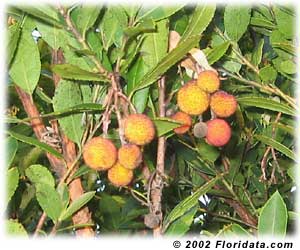
The strawberry tree produces masses of beautiful white flowers followed by small fruits. Since the fruit takes 12 months to ripen, the tree carries both mature fruit and flowers at the same time and is then incredibly beautiful. This is a superb plant to grow as a specimen in a lawn, and it also grows very well on the sunny edges of a woodland garden.
Best grown in a rich, well draining soil for best results, though it will grow to some degree in most type soils, except for water-logged soils. Does well in full sun or partial shade.
The small strawberry shaped fruits ( hence the name )have gritty skin and must be fully ripe to be eaten. It has a sweet, delicate flavor that some people love, and others do not care for. The fruit can also be made into wine and is used to make delicious jams and preserves.
Grow this shrub in USDA Zones 7-10. It originally comes from western Europe and the Mediterranean region.
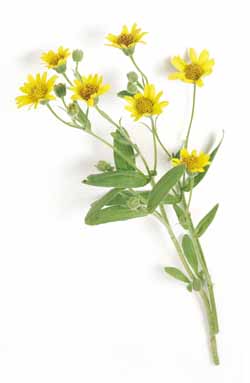

This is a tall ferny green plant that grows to over seven feet high and four feet wide in one year! Excellent for back borders or any area that you want to give a tropical look and feel. Sweet Annie has thick strong woody stems and branches out like a shrub. The flowers are tiny and olive green and can't really be seen unless you look hard. However sweet Annie is grown for it's foliage and mostly for it's lovely aromatic scent which can fill the whole garden when the breeze rustles it branches. It has been used for centuries in it's dried form in wreaths and other aroma projects.
Sweet Annie is one of the best natural air fresheners around. Have a aroma you want to get rid of? Just wave a spring of Sweet Annie in the air and it freshens the whole area with a sweet appealing smell illuminating anything else. Don't use air fresheners with unknown chemical ingredients use a natural herb to do the work for you. The plant dries very well and the will last for years all you have to do is gently move a piece and the aroma bursts forth. It is excellent for use in wreaths and other aroma projects.
Germination is about 50 percent, normal for this variety.
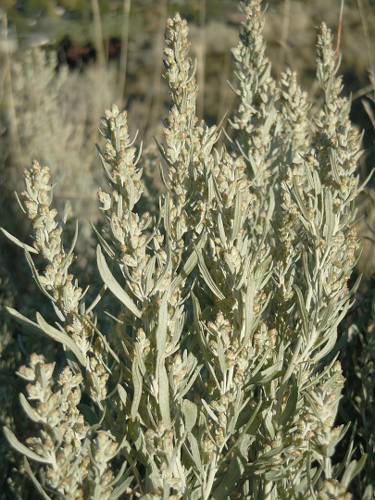
Strongly aromatic. Used by the Montana Indians as a general tonic, to restore hair, and as a dermatological aid.
Zones 3-5.
Low germination by nature, we estimate about 25 percent being normal.
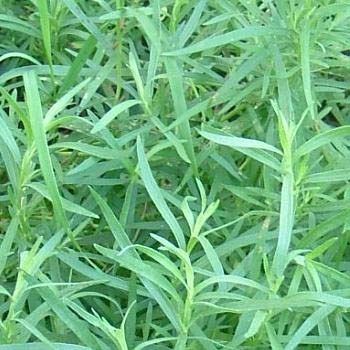
A perennial plant for zones 4-9.
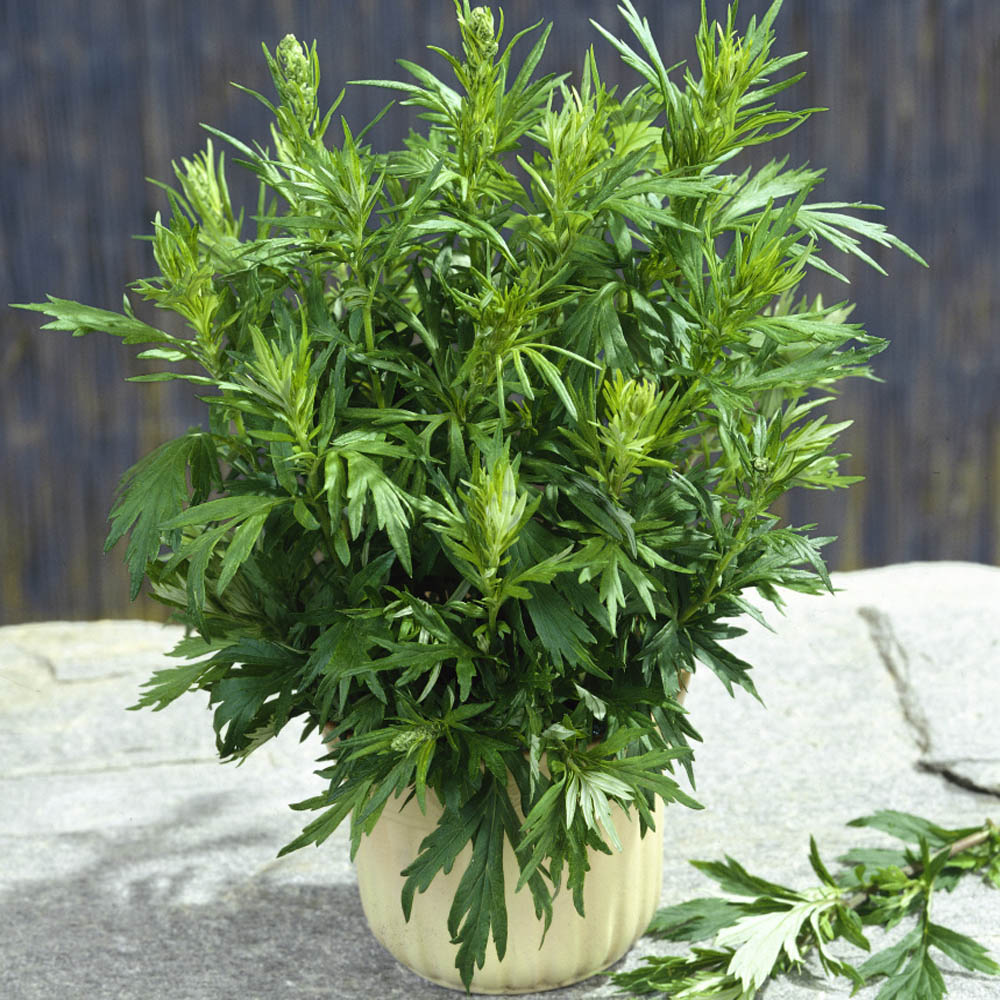
During the summer, mugwort displays small red, pink, orange, and yellow flowers. Although they aren't as showy as a lot of prized garden plants, they look lovely in dried flower arrangements.
Their height means they can act as an attractive backdrop for smaller border or walled garden plants, and they also give off a pleasant sage-like fragrance. Many cultures have used mugwort in teas and traditional foods. In Europe it was used to flavor beer before the introduction of hops. Only dried plants were used because it was believed that the fresh leaves did not have the same flavor properties.
Mugwort contains small amounts of thujone which is a spasmodic. In small amounts, it isn’t harmful but if eaten in large quantities, it is toxic. Pregnant women should never consume mugwort because of the danger of early labor and miscarriage.
A perennial for zones 3-8. Grows about 40-60 inches in garden soil.
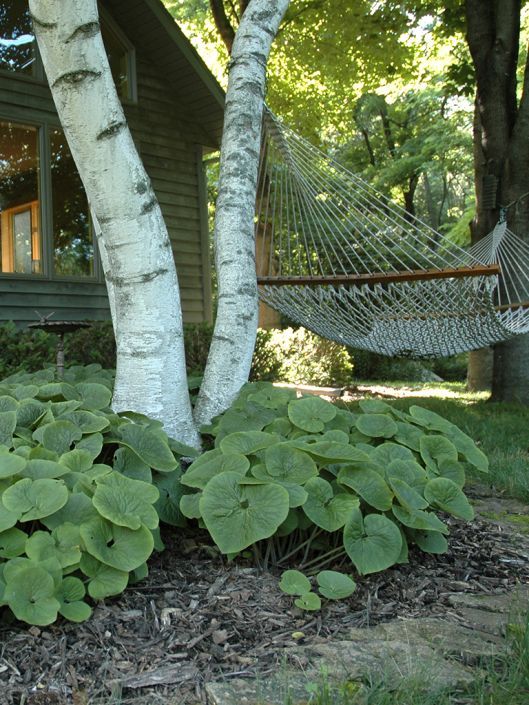
Although unpalatable to deer and other mammals, it is an important food source for the Pipevine swallowtail Butterfly. Many insects are attracted to Wild Ginger, including ants, believed to pollinate the plant. It's best to propagate this plant by divisions rather than try to get it going from seed. Divide plants in the early spring before they are actively growing or in the fall as they go dormant.
Many Native American Indian tribes used the root of the Wild Ginger plant as a seasoning or to treat colds and fevers. European Settlers to this continent also learned to use the root as a flavor substitute to the tropical ginger they were used to. Other common names include Woodland Ginger, Ginger Root, Heart Snakeroot, Indian Ginger, Asarabaca, and Catfoot.
Seeds need a warm, moist period followed by a cold, moist period Mix seeds with sterile media. Place mixture in a sealed plastic bag in a warm place (about 80°F) for 60 to 90 days. Then place in refrigerator (33- 38°F) for 60 to 90 days before sowing. Or, sow outdoors and allow one full year for germination.
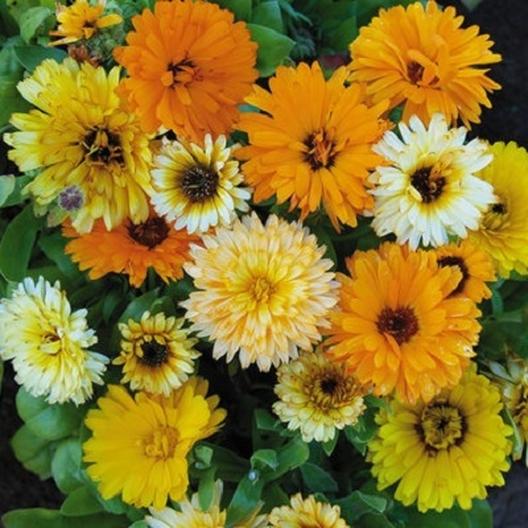
Medicinal uses included treatments for measles and smallpox, as well as for dressing wounds on the battlefield. As well as being the traditional flower for October birthdays, calendula symbolizes sorrow and sympathy. Calendula flowers are edible and ideal in salads. Grows about 12" tall.

It is believed to relieve high blood pressure and normalize sebum secretion for skin problems, and is considered to be an aphrodisiac. The oil from ylang-ylang is widely used in perfumery for oriental- or floral-themed perfumes (such as Chanel No. 5). Ylang-ylang blends well with most floral, fruit and wood scents.
In Indonesia, ylang-ylang flowers are spread on the bed of newlywed couples. In the Philippines, its flowers, together with the flowers of the sampaguita, are strung into a necklace (lei) and worn by women and used to adorn religious images. Will flower in a container. Great tropical flowering tree! Zone 10 and higher outside or grow as a patio plant in cooler zones.
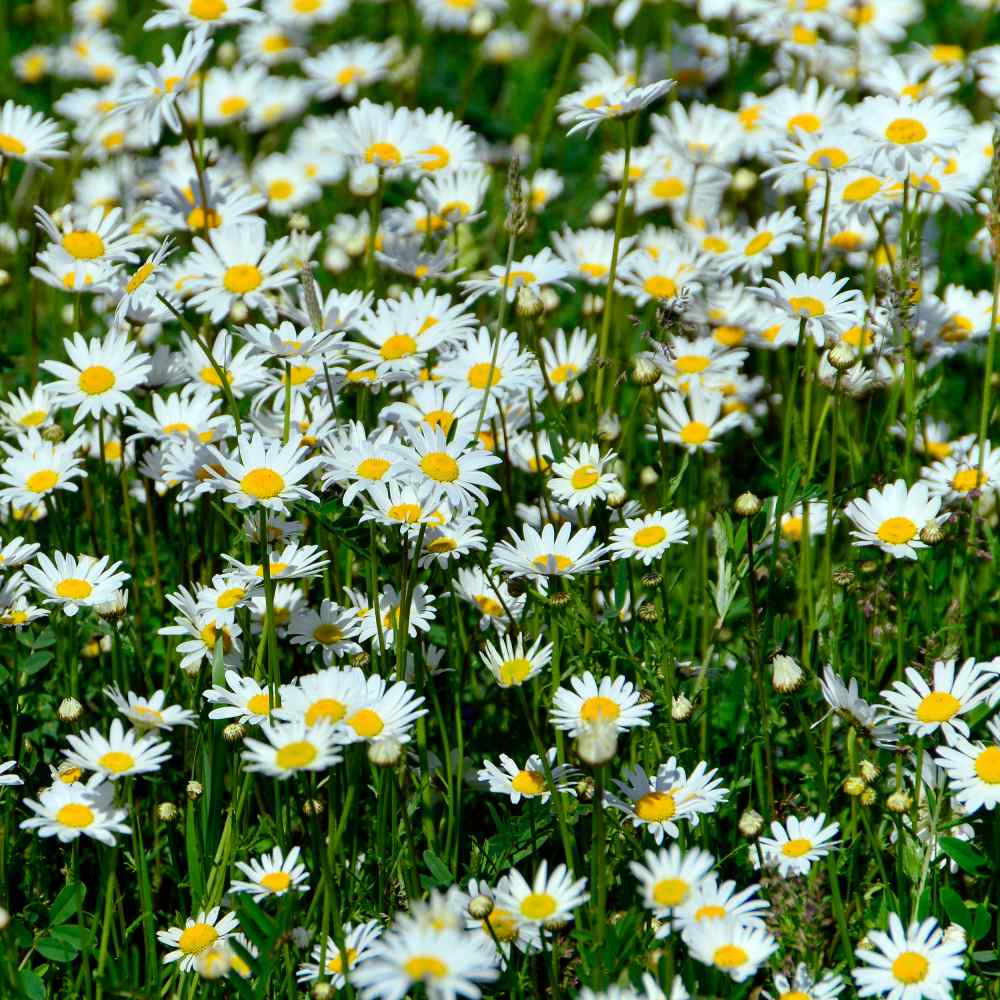
This herbal carpet can even be used as a lawn substitute. This species is grown for the famous British Chamomile lawns.
Roman Chamomile plants may deteriorate in very cold or wet winters, but they will most likely recover. Harvest chamomile flowers when they are first fully opened. Use them fresh or freeze them for later use. Another benefit is that the flowers are used in herbal teas and are said to have medicinal properties.
Often used as a ground cover, Roman Chamomile holds soil in place even on slopes, it spreads to fill in gaps, and it blocks out most weeds. It can be mowed (after flowering and set the mower on the highest setting), and it tolerates light foot traffic. This ground cover is unique, aromatic, attractive and is well-suited for covering large areas and can be started by sowing the herb seeds ( Sow on cultivated soil. Sowing Rate: Approximately 5,000 seeds covers 100 square feet. Average Germ Time: 7 - 10 days. Keep moist until germination. Depth: Surface sow, cover lightly with peat moss. )
Attracts honeybees and birds. Young leaves and flowers can be gathered to make a calming tea, both fresh and dried.
Grows well in zones 4-9.
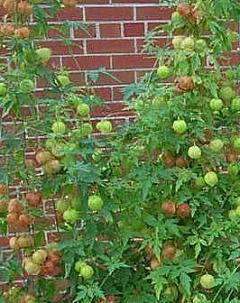
Leaf juice is used for earache. Cooked and eaten in India and Africa. Decorative black seeds with cute heart-shaped white faces are used for necklaces.
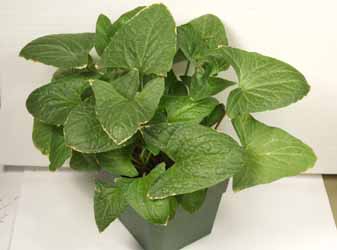
Good King Henry may have become something of a rarity today, but this unique herb still has much to offer to the home or cottage gardener.
A perennial herb in the family Chenopodiaceae, the same plant family as some familiar vegetables (including beetroot and chard) and some other useful but more unusual plants including quinoa and tree spinach. This unique herb possesses many unusual functions. One of its many common names is "All Good" and pretty much all of the plant can be eaten.
The succulent young leaves and flowering stems can be either eaten in salads or cooked like spinach. The seed can be ground and mixed with flour then used in making bread. Known as 'poor man's asparagus', the growing shoots can be tie together in bundles, cooked and eaten like asparagus. Considered to be a gourmet food, young flower buds can be sauteed in butter
It has been used as a herbal medicine to alleviate stomach-ache. The seed is a gentle laxative that is suitable for children. Chickens especially seem to have a special fondness for Good King Henry; one of its common names is "fat hen".
The root is used as a cough remedy for livestock such as sheep and goats.
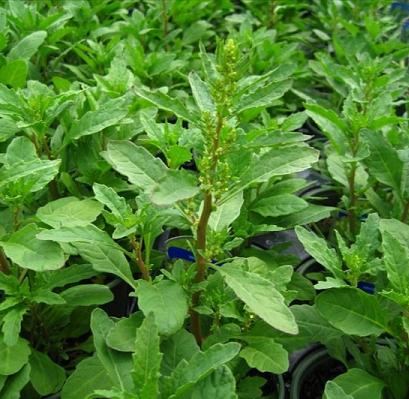
Epazote is such an herb. Epazote is used medicinally to treat internal parasites. Epazote is an abundant weed in Mexico and parts of northern South America. There, its bitter, musky, lemon flavor is used to spice up everything from beans and squash to pork and crab cakes. Young leaves can be wilted and added to soups or stews or combined with other greens, just as chicory or sorrel would be used in early spring. It is often used with other herbs, like Mexican Oregano and Cilantro, and, of course, chilies.
A tender perennial herb, Epazote has proven itself hardy in our Zone 8 winters. It dies back to the ground each winter but returns in spring. A heat loving herb whose flavors are best when grown in full sun, Epazote can be grown in a medium size container and placed on sunny window or under lights for the winter, if your winters dip much below 20.

Start Chervil seeds and grow this popular annual that is considered to be both a medicinal herb as well as a culinary herb. Chervil, also known as French Parsley, is also an attractive plant with finely-divided, fern-like leaves. It likes a position in the shade during the hottest part of the day. If it is positioned in full sun, the delicate foliage can suffer and become burned and bleached. Chervil French Parsley is fast growing and harvesting can be as soon as 8 weeks after planting the herb seeds. Some gardeners will sow the Chervil seeds in successive plantings to keep a constant supply of leaves.
For culinary use, both the roots and leaves are used. The French Parsley herb roots can be harvested in mid-summer and stored like a potato for later use in soups. The leaves are the most widely-used and have an anise-parsley flavor. Chervil leaves are a great addition to salads and soups. The flavor lends itself well to fish, crab, meats, vegetables and sauces. Chervil also had a therapeutic property being used as a diuretic and for skin ailments.
Extremely sweet and aromatic herb. Leaves are similar to parsley in appearance, but more delicate.
Usually grown as an annual for best results. Grows about 12" tall, 120 days till maturity from seed.
Thriving in cooler weather, chervil will often over-winter in milder climates if sown late or allowed to self-seed. It is an easy-to-grow herb and can be sown and grown in a windowbox or trough, in pot on a deck, or indoors on a windowsill as long as the container is deep enough to support its long taproot.
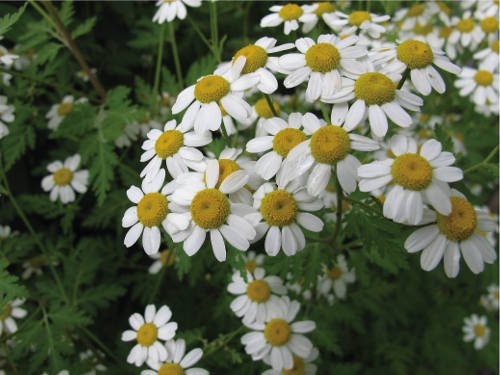
Feverfew is a medicinal herb with a long history of use. The leaves are dried and used as an herbal remedy for migraine headaches. The Feverfew herb contains parthenolide which can relieve mild spasms and is an anti-inflammatory. Some people take it to relieve the pain of rheumatoid arthritis.
A perennial plant for zones 5-9.
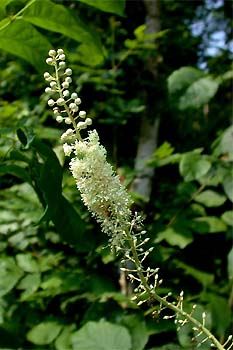
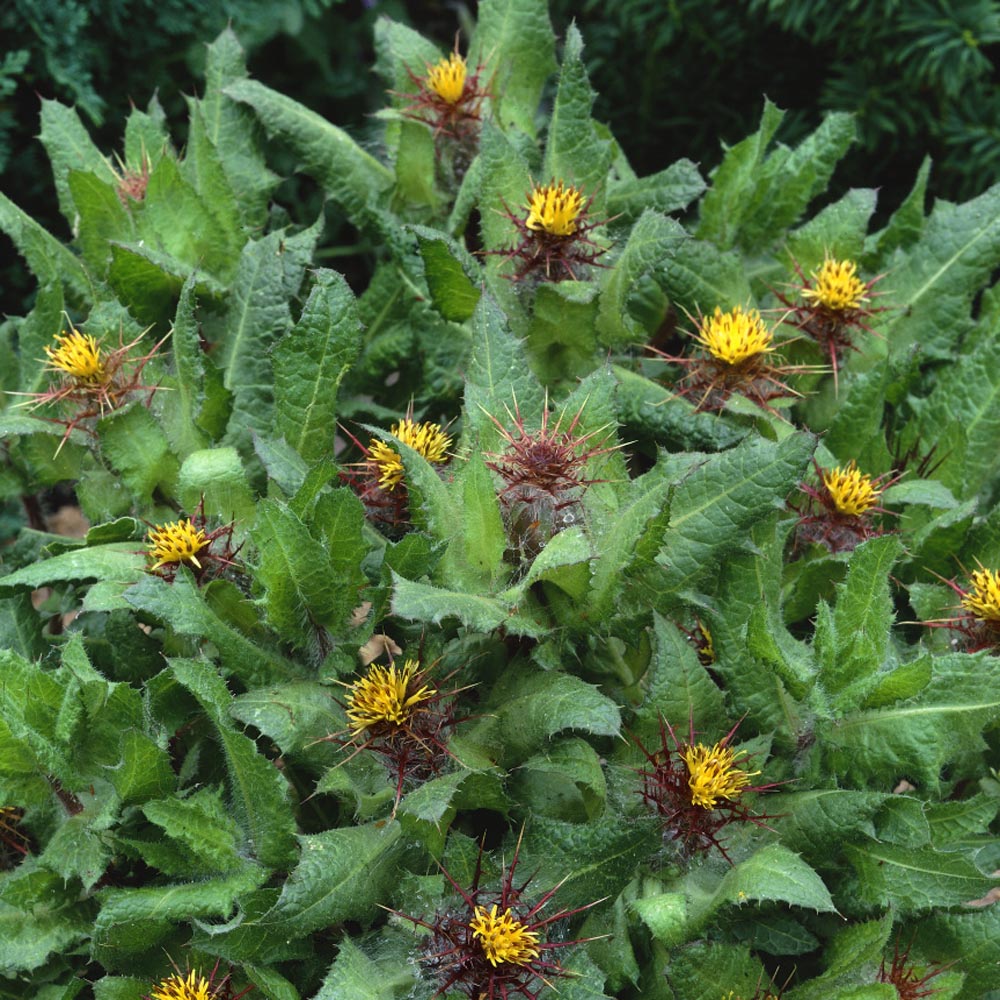
The flowering tops, leaves, and upper stems are used to make medicine. Young tender leaves can be eaten, or dried leaves can be used to make teas. The Blessed Thistle herb has been used to treat numerous ailments over the centuries, including the plague. Today it is used to promote milk production in lactating women and for menstrual problems.
How To Grow Blessed Thistle: Sow Blessed Thistle seeds directly outdoors in the spring after danger of frost has passed. Blessed Thistle grows best in an area of the garden that receives full sun. The ground must offer good drainage. Harvest before it flowers. Plant can be cut back by 1/3 and harvested 2 - 3 times during a growing season. If a few flowers are allowed to go to seed, it will re-seed for next year's use. Birds also enjoy the seed, so some gardeners recommend gathering the herb seeds and sowing it to ensure next year's supply.
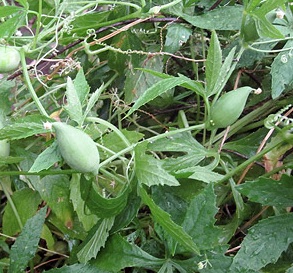
Can easily be grown in the garden, on a fence or trellis. It is an annual plant. One of the most interesting aspects of the plants is that when ripe, the fruits become spring-loaded missile devices, splitting and turning themselves inside-out to launch their seeds up to 5-6 feet away into the garden. This is quite the conversation plant.
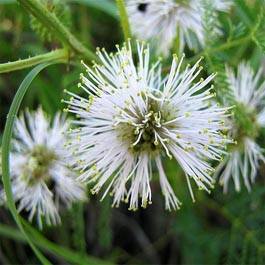
Illinois bundleflower is rated by some authorities as our most important native legume and is included in range revegetation programs since the species is readily eaten by livestock. The lenticular seeds contain 38 percent protein on a dry weight basis, which compares favorably with soybeans.
Seeds are desirable for wild birds. The plant is considered a nutritious and palatable browse for wildlife.
Pawnee Indians used leaf tea as wash for itching. Hopi used seeds placed in eye for conjunctivitis.
A perennial growing to 3-6 ft. tall with cream colored flowers. Hardy to zone 5. The primary attraction of Illinois Bundleflower is the refined appearance of its fern-like foliage. The subleaflets of the compound leaves fold together at night, and they close partially during hot sunny days in order to reduce moisture loss. During the morning and evening, when sunlight is less intense, the compound leaves orient themselves in the direction of the sun in order to maximize the reception of its light.
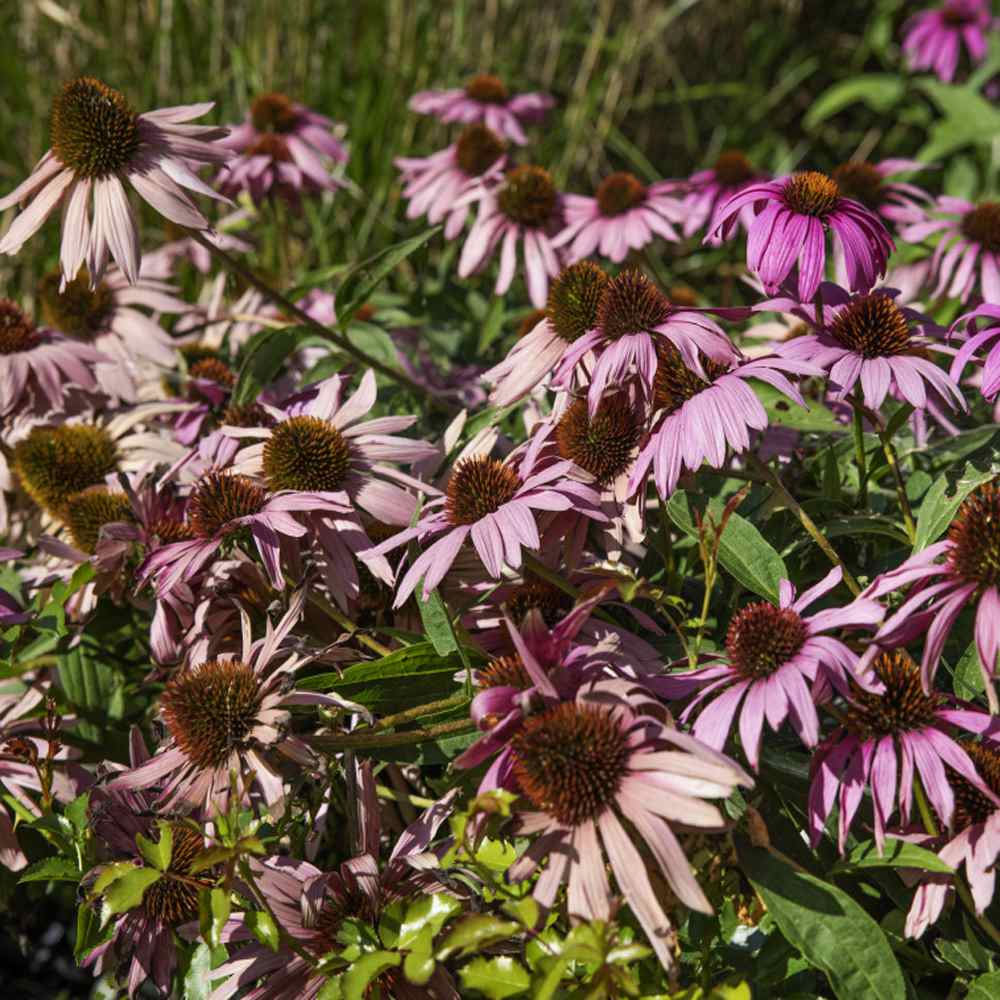
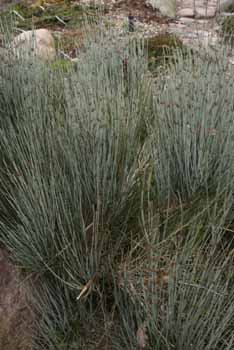
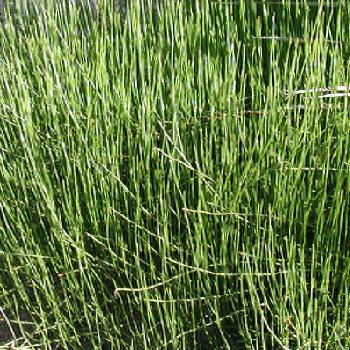
It makes a nice tasting tea with a somewhat astringent flavor, the dried branches are boiled in water to make the tea. People use it as a beverage and as a herbal medicine.
Be careful not to confuse Mormon tea (Ephedra nevadensis) with ephedra (Ephedra sinica and other ephedra species). Unlike these other plants, Mormon tea does not contain ephedrine ( or only slight traces ).
The Mexicans call this herb by the name popotillo, while the early European settlers in America called it by several other names, such as Mormon tea, teamster's tea and Brigham tea. There was a time when this herb was an extremely favourite conventional medication for treating sexually transmitted diseases like syphilis and gonorrhoea.
However, this herb has a somewhat astringent flavour, but people who have a preference for it or have become habituated to it, like this herb and take it in the form of a pleasingly reinvigorating drink. The herb has probably got its name Mormon tea from its use in the form of a caffeine free beverage that quenches thirst.
We recommend you research more on this herb by visiting sites like WebMD/Mormons Tea and Herbs2000/Mormons Tea, there are also many other sites on the web with useful info on this herb.
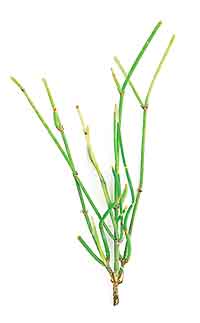
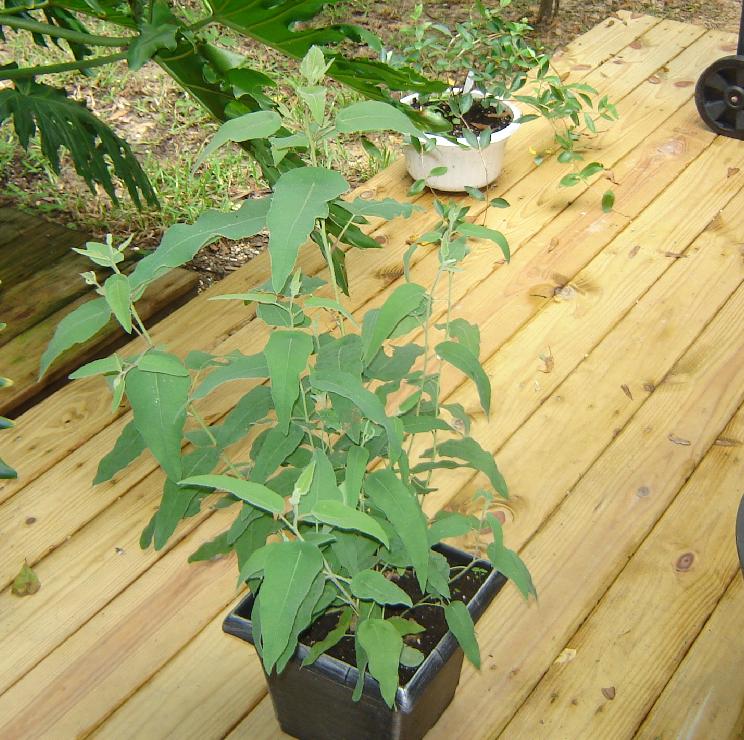
Before walking in the woods, I will pick a few leaves, crush them and put them under my cap, this works very well.
Commonly known as Lemon Bush. This aromatic plant starts easily from seed. When grown in a container, it only reaches 3 to 4 feet tall. No matter where you live, you can grow this lovely plant from seed in your own home and enjoy the fresh lemony fragrance. Its fresh and lemony aroma is uplifting and simply brushing the leaves will release more fragrance that will remind you of the citronella candles sold to repel mosquitos. Outside in warm zones, it will grow into a small tree, but is most commonly grown as a container plant in cooler zones. It produces sword-shaped gray-green leaves, tiny white blooms, and a bit of red fall foliage change. For growing indoors, find a nice container and grow from seed in a bright window. It can also be grown outdoors, but bring it in before the first frost to winter it indoors.
Oil from the leaves is applied to the skin as a medicine and insect repellent. Citrodora Ecalyptus oil is used for preventing mosquito and deer tick bites. It is also an ingredient in chest rubs used to relieve congestion. The oil has a strong fresh citronella-like odor with a sweet balsamic undertone. Very effective insect repellent due to a higher citronellal content than citronella ( which is commercially harvested from citronella grass, a different type of plant and is used in many insect repellants ).
Eucalyptus Citriodora has good branching and makes an attractive container plant with wonderful citrus-spice fragrance. It is actually an herb, and its 3-inch leaves are bold and dramatic indoors, and the white summer blooms add another interesting dimension to this versatile plant.
The plants are winter hardy in USDA zones 8-11, but can be grown as a container plant or annual in any zone.
Trees bloom in winter in outside in warm zones, in the greenhouse they bloom in late winter to early spring. The white blooms are not very distinctive. The blooms are followed by woody urn-shaped capsules about 3/8 of an inch wide.
Eucalyptus citriodora need full sun with a well-drained soil mix for container growing. Most gum trees grow in very nutrient poor soils and fertilizer is not needed; however container plants should be feed once during the spring. To control the size of the trees in containers, do all pruning and repotting in late to early spring after flowering.
How to start seeds and grow:
Start seed indoors into a starter tray. ( We like to leave seed packet in the fridge for 30 days before sowing, this seems to enhance the germination ). Press the seed into the soil and cover lightly, about twice the thickness of the seed. Keep the seeds moist by watering from underneath. Once the seedlings are 4 to 5 inches tall, transplant into containers. Start with a 1 to 2 gallon container with potting mix and after a year or so, transplant into a larger 3 to 5 gallon container. Feed monthly during the growing season with water soluable plant food or mix granular 5-10-10 fertilizer with micronutrients into the soil each year.
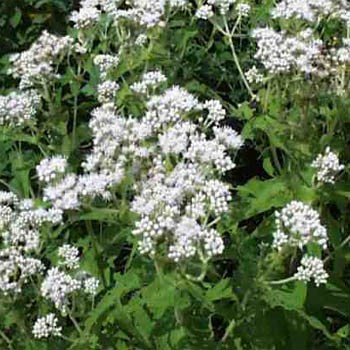
They make a lovely addition to the wild flower garden or to the back of the perennial garden as they can reach 48 inches in height.
Historically, the Boneset plant was commonly used by some North American Indian tribes and lay herbal doctors for its properties as a febrifuge, laxative, stimulant, and diaphoretic. The Boneset herb was often used to treat flu epidemics, and still today, some use the dried leaves and flowering tops to make Boneset tea or tincture to treat colds and flu. Hardy to zone 3.
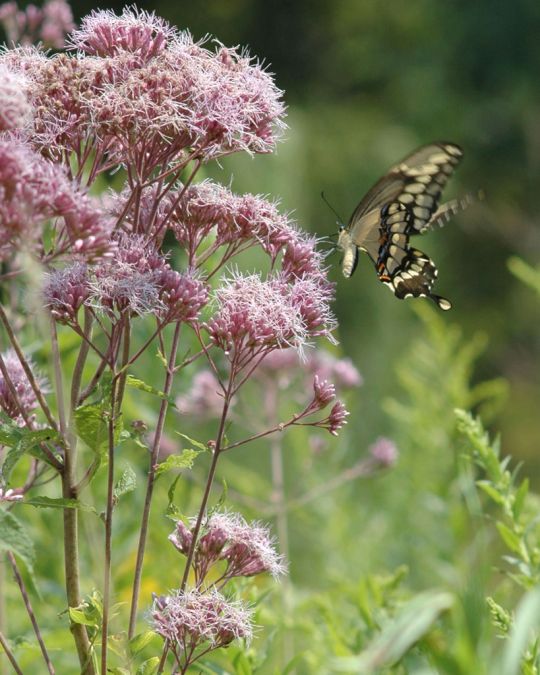
Also called Spotted Joe Pye Weed, it is best planted in full to almost-full sun and rich, moist soils. It will spread so should be planted with caution in small landscape situations.
According to Plants For a Future website, a tea made from the whole herb is diuretic it is used in the treatment of kidney complaints, painful urination, rheumatism etc. A tea made from the roots is used in the treatment of fevers, colds, kidney and liver complaints, rheumatism etc.
A perennial best suited for zones 3-8. Needs cold stratification before germinating.
An herbal answer to aspirin that will not upset the stomach. An infusion made by steeping two teaspoons of dried leaves in a cup of water for 15 minutes can relieve discomfort due to fever, respiratory problems and arthritis. This infusion should not be given to children. The plant has very fragrant leaves that make a delicious herbal tea that is good for headaches. A hardy perennial that grows 4-6 feet tall. Best suited for zones 3-8.
A note from one of our customers:
The replacement seeds arrived! I thank you for your concern, and integrity. I certainly hope these seeds were not exposed to as much heat during shipping! Once again, I thank you. Your business ethics are admirable, and I will certainly give you, and your business my recommendation to other individuals who seek seeds!
Sincerely, David Kastner )
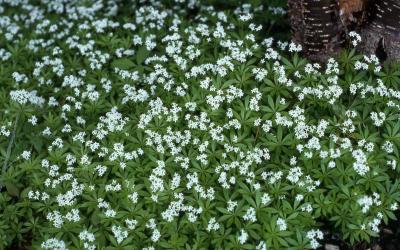
It does make an excellent ground cover plant due to its low-growing nature and spreading habit. Historically, the herb seeds were grown for an aromatic plant that was used as an air freshener and placed in linen closets.
Plants are also natural insect repellents and gardeners often grow them around ornamentals like roses to keep the pests away. As a medicinal herb, Sweet Woodruff was used to treat numerous ailments and was often used for the treatment of wounds.
Plants emit a strong odor of freshly mown hay when foliage is crushed or cut. Aromatic intensity of the foliage increases when dried, thus dried leaves are popularly used in sachets or potpourris.
Plants have also been used commercially in perfumes. Leaves are sometimes used to flavor teas and cold fruit drinks. Leaves are also used to make May wine, a punch made from white wine flavored with woodruff, orange and pineapple. Woodruff comes from Old English meaning wood that unravels, in probable reference to the creeping rootstock of the plant. Formerly known as Asperula odorata. Cannot ship to CN, MA, NY, PA, VT
Sweet Woodruff seeds germinate best after a period of cold temperatures. Some gardeners will dampen peat moss, mix the herb seeds into the peat moss and then place the peat moss/seed mixture in the refrigerator for 2 to 4 weeks before sowing. Others will sow the herb seeds in a starter tray, water, seal the tray, and place it in the refrigerator. Finally, the last method of sowing would be to directly sow the Sweet Woodruff seeds outdoors in a prepared seedbed in late winter or first of spring while frosts are still expected.
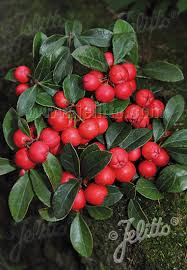
Creeping shrub that grows 6 inches tall with scalloped, glossy dark green leaves. Blooms urn shaped white or pale pink flowers in summer that mature to scarlet fruit.
Plant in an area that receives light shade, or remains shaded throughout the day. Shade tolerant, but will not tolerate drought. Excellent choice for native gardens, and functions as a woodland ground cover.
Makes a nice container plant for shaded patio areas. Excellent ground cover for shady areas. Woodland gardens, rock gardens, foundations or native plant areas. Plants are an interesting complement to other acid-loving shrubs such as azaleas, rhododendrons, kalmias and blueberries.
Foliage was once used to make oil of wintergreen which has astringent, stimulant and diuretic properties. Wintergreen has been a popular flavoring for chewing gum, candies and toothpaste. Dried leaves can be used to make an interesting tea (teaberry is a sometimes-used common name for this plant), but this usage is no longer recommended. Leaves were once made into poultices for arthritic pain and sore muscles. Fruits may be eaten raw or added to pastries and salads.
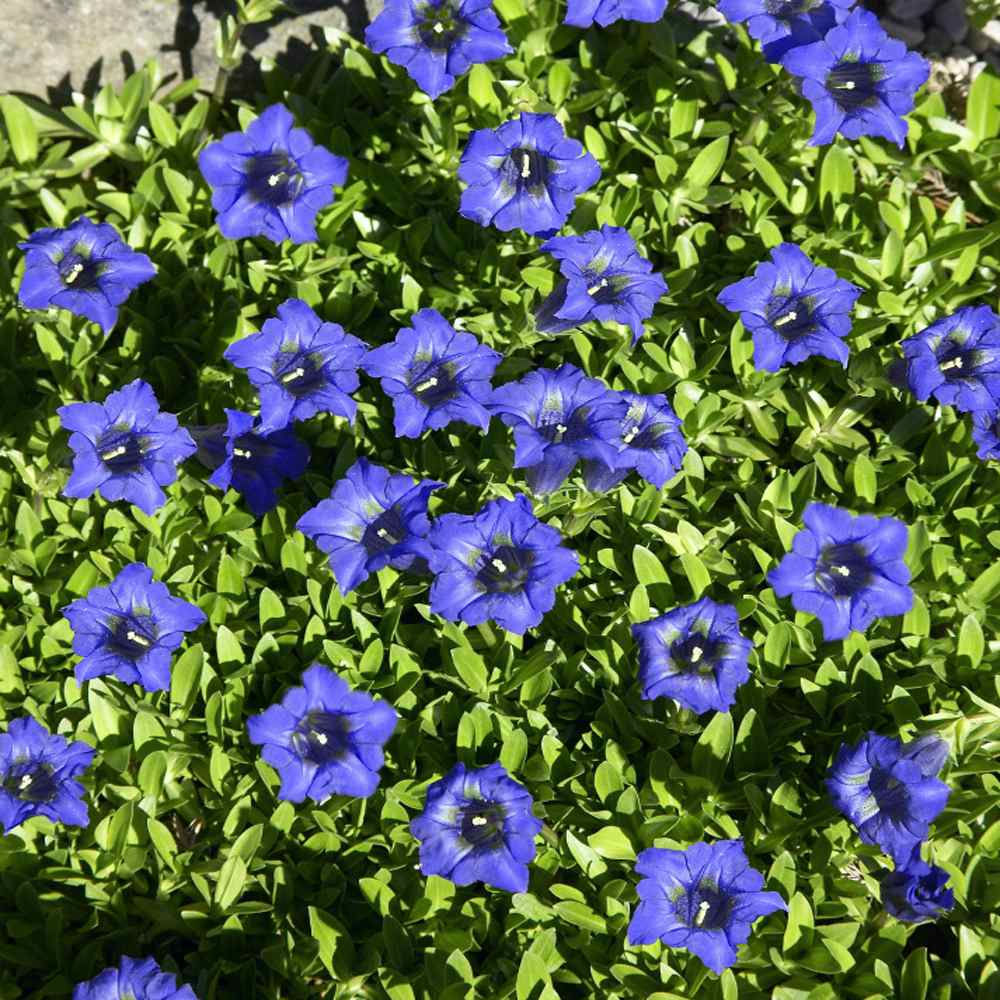
How To Grow Common Gentians: Gentian seeds require some patience in getting them to germinate. There are two recommended methods for starting the seed. First method, in the spring, mix the herb seeds in a moist growing medium, place in a freezer bag, then stratify by refrigeration for two months. Second method, in the fall place the Gentian seeds in starter trays with seed starter mix that has been moistened. Cover the trays with glass or plastic to help keep the moisture in. Place the trays in a cold frame outdoors or place the flat in a protected area outdoors. Gentian seedlings can be transplanted into their permanent place either in spring or fall. Gentian plants require moist, humus soil that drains well.
Perennial for zones:3-7. Height: 10 inches
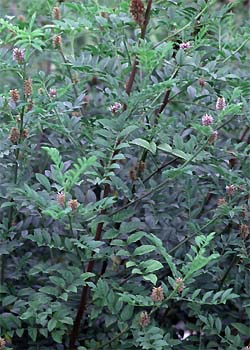
Extracts flavour tobacco, beer, soft drinks and pharmaceutical products. Powerful anti-inflammatory properties effective for arthritis, gastritis, canker sores. Also a mild laxative. 3 year old roots are harvested in the autumn.
Used for flavoring and medicine.
Medicinal: For throat, stomach, urinary, and intestinal irritations. Energy and hormonal balancing.
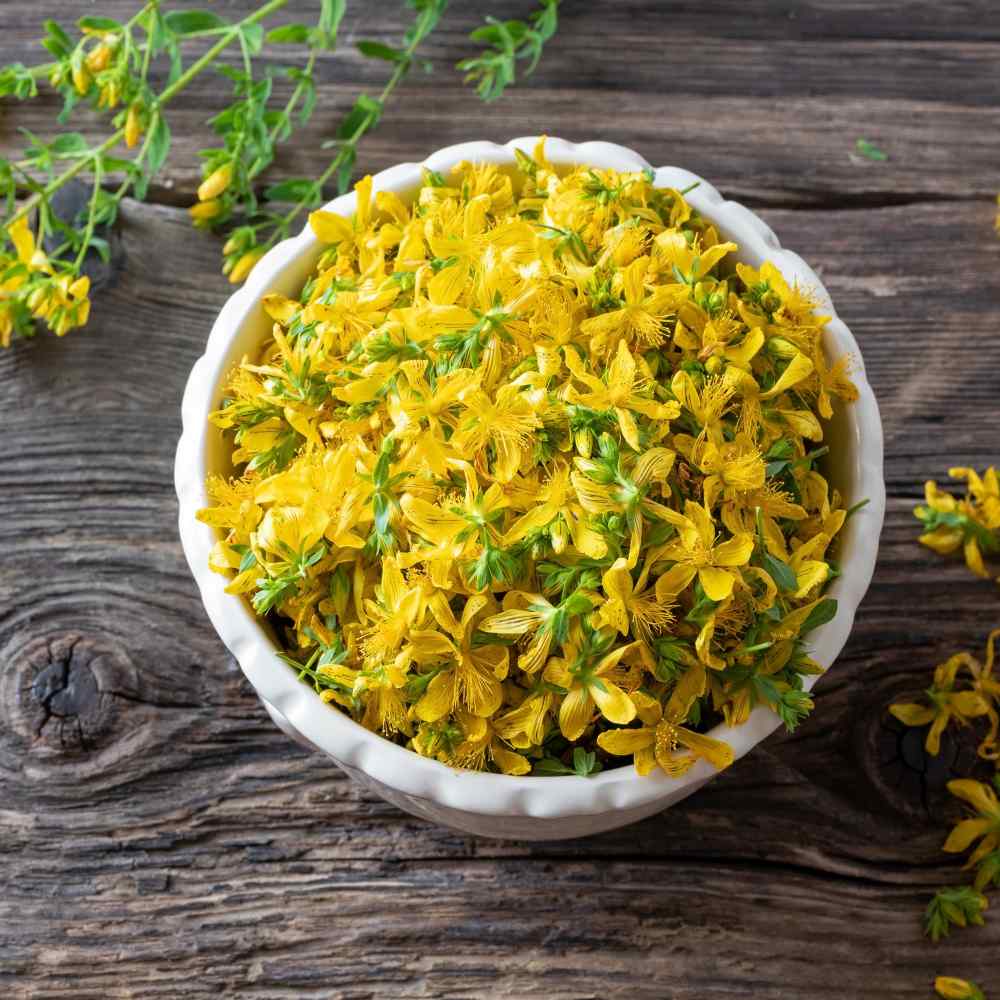
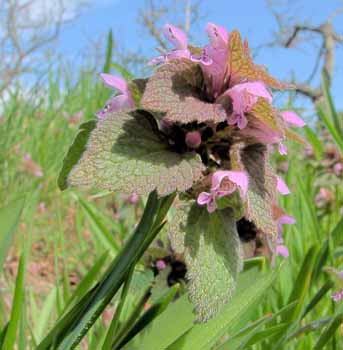
Attractive beeplant and medicinal herb with purple-tinged foliage and purple-red flowers. Unlike its nasty distant cousin, the stinging nettle, this nettle does not sting which explains the name. Flowers and foliage stop hemorrhages; tea is useful against chills as it acts on the kidneys and induces sweating.
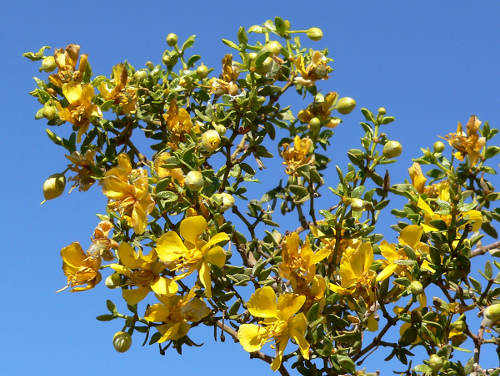
One of the best xeriscape and rock garden plants, this evergreen shrub, often called ‘greasewood’ flourishes under the intense daytime heat of the Sonoran, Chihuahua and Mojave Deserts. Creosote bush thrives under 5,000 feet.
Creosote has a long history of medicinal uses. Indigenous people rely on creosote as a ‘cure-all’ plant with wide reaching applications. Ethnobotanical notes mention creosote was used as a cure of fever, colds, stomach pains, a general pain killer, diuretic, arthritis, sinusitis, anemia and an anti-diarrheal.
Creosote bush is also antimicrobial. Thereby the plant is useful for cuts and bacterial or fungal infections.
A hardy perennial for zones 7-11.
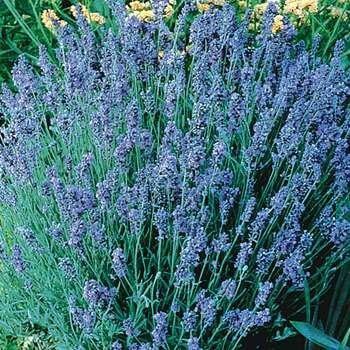
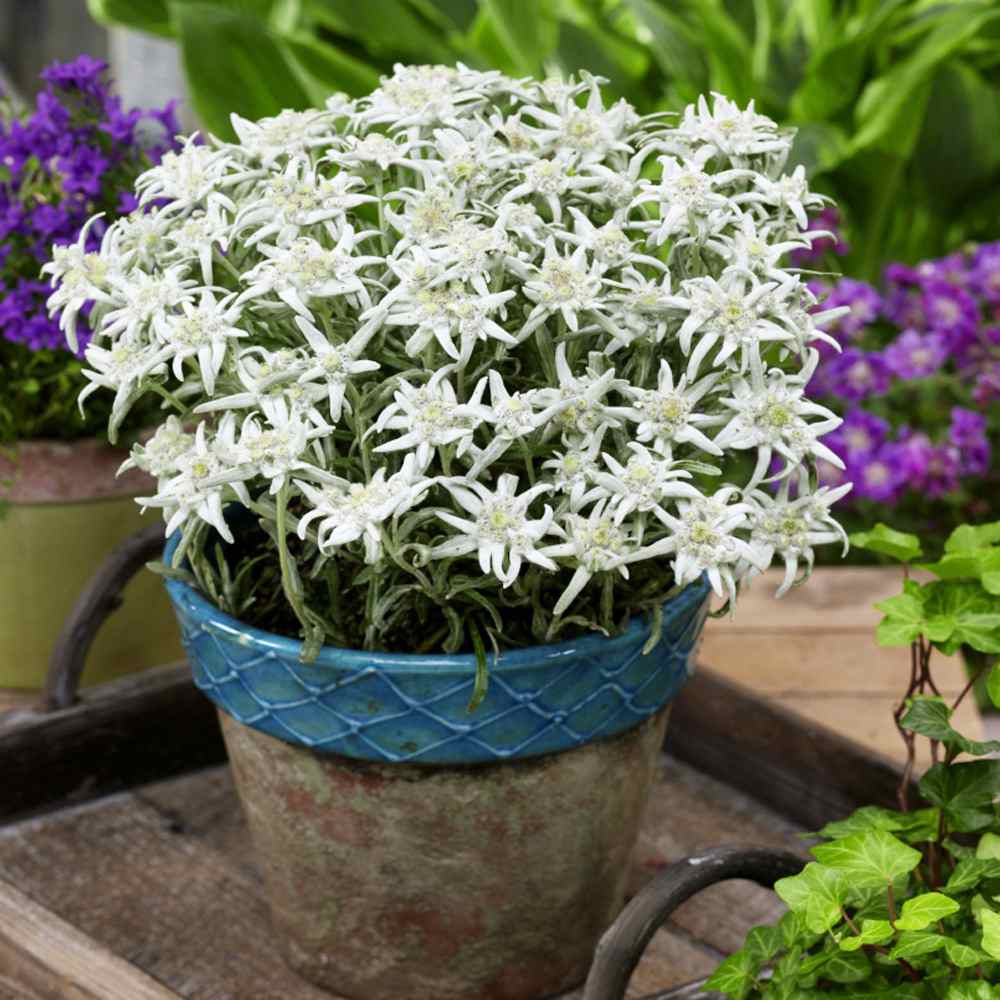
The Edelweiss flower is good for cutting, and it can be used in fresh or dried arrangements. Europeans historically have used the Edelweiss herb as a tea to treat diarrhea and dysentery. Edelweiss herb plants are also used widely as a cosmetic cream to aid healing and control facial wrinkles.
The Edelweiss Leontopodium Alpinum plant is low-growing and makes nice compact border plants. They will sometimes self-seed and come back even stronger the following spring. Best in regions with cool summers. Drought-tolerant once established.
Perennial plant for zones 3-9.
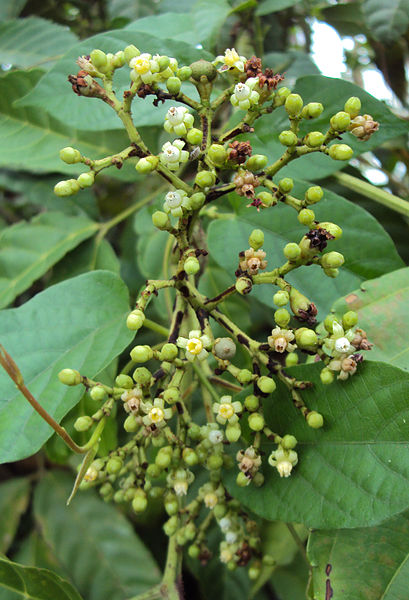
The plant is gathered from the wild for local use as a food and medicine. It is locally cultivated in India and China for medicinal purposes.
The juice of young leaves is used as a digestive. Young shoots are chewed to relieve a severe cough. The pounded leaves are used for poulticing cuts and skin complaints in general. They are placed upon the head in cases of fever, headache and as a general anodyne for body pains. The leaf juice is applied on the head as a remedy for dizziness or vertigo. A decoction of the shoots is applied to sores. [Ref] The root is considered antipyretic and diaphoretic. It is used to relieve muscular pain, and is an ingredient of a preparation to treat leucorrhoea, intestinal cancer and cancer of the uterus. A decoction of the roots is taken to relieve stomach-ache, colic, dysentery and diarrhoea[Ref]
Zone 9b and higher outside.
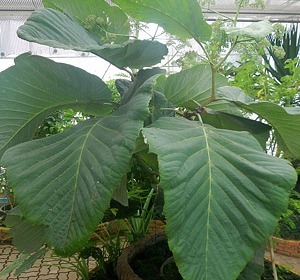
Native to India, Nepal, southwestern China and Southeast Asia, it is occasionally planted as an ornamental and as a unique patio and houseplant. The leaves are edible as a vegetable but of limited palatability. Leea macrophylla has also been investigated for anti-cancer properties and is used in traditional medicine.
Zone 10 and higher outside, or inside in warm brightly lit areas.
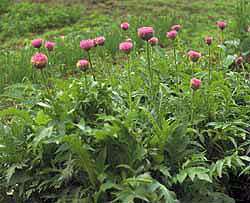
Studies show that the root extract greatly increases the work capacity of muscles and normalizes blood sugar levels quickly after exertion, and improves memory and learning. Contains ecdysteroids which have anabolic-like growth promoting effects without the side effects associated with drugs.
Violet flowers appear in the second year, reaching 30-60in in height. Grows in deep, well-drained fertile soil in full sun. Very hardy.
Perennial (hardy in zones 2-7)
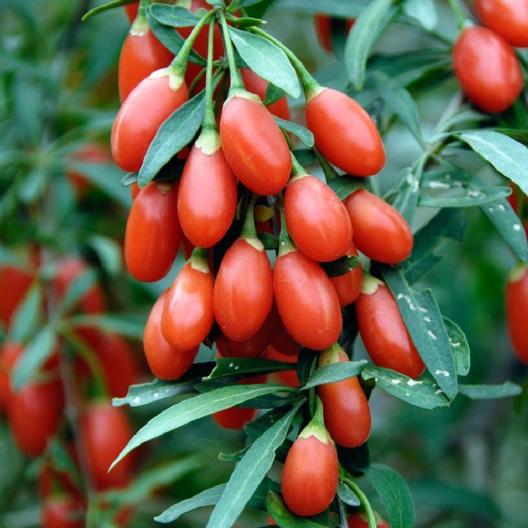
A graceful shrub that bears large edible berries. The leaves are also edible when fresh and used in salads. A wine is made from the fruit that is said to prolong life. A perennial for zones 5-9.

And what is highly unusual for fruits, they are rich in essential fatty acids. This combination of protective, healing and nutritive constituents help explain the many benefits of this plant. It is traditionally used to treat diabetes, anemia, heart disease, impotency, abnormal menstuation, menopause and problems of the liver and kidneys. It reduces cholesterol, helps regulate blood pressure, and improves circulation.
It also improves vision problems and dizziness. In Kashmir it is used to treat blindness in camels. Studies have shown that black gojiberry protects against radiation and may help reduce the side-effects of radiation therapy. As well, the berries boost the immune system and help prevent or slow the growth of cancer.
Black gojiberry is a spiny shrub found in dry areas from Turkey and Armenia to Tibet and northwestern China. It does well in dry, well-drained soils, and requires full sun. The seeds germinate readily but the seedlings are susceptible to damping off and control of damping off is necessary for best results.
Best sown in spring, kept in pots the first season, and then planted in the garden the following spring. Depending on conditions, plant will grow from 16-36 inches tall.
Based on its natural range we believe it is hardy to at least zones 4 to 7. It can be grown in warmer zones if provided with partial shade during the day.
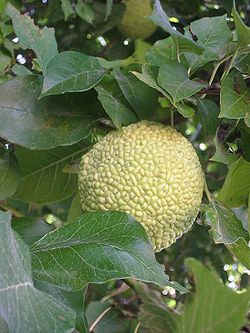
Recent research suggests that elemol, another component extractable from the fruit, shows promise as a mosquito repellent with similar activity to DEET in contact and residual repellency. Notes:The Osage-orange is commonly used as a tree row windbreak in prairie states, which gives it one of its colloquial names, "hedge apple". It was one of the primary trees used in President Franklin Delano Roosevelt's "Great Plains Shelterbelt" WPA project, which was launched in 1934 as an ambitious plan to modify weather and prevent soil erosion in the Great Plains states, and by 1942 resulted in the planting of 30,233 shelterbelts containing 220 million trees that stretched for 18,600 miles (29,900 km). The sharp-thorned trees were also planted as cattle-deterring hedges before the introduction of barbed wire and afterward became an important source of fence posts. The heavy, close-grained yellow-orange wood is very dense and is prized for tool handles, treenails, fence posts, electrical insulators, and other applications requiring a strong dimensionally stable wood that withstands rot. Straight-grained osage timber (most is knotty and twisted) makes very good bows. In Arkansas, in the early 19th century, a good Osage bow was worth a horse and a blanket. Additionally, a yellow-orange dye can be extracted from the wood, which can be used as a substitute for fustic and aniline dyes. When dried, the wood has the highest BTU content of any wood, and burns long and hot. Today, the fruit is sometimes used to deter spiders, cockroaches, boxelder bugs, crickets, fleas, and other arthropods.
Leaves turn bright yellow in fall, thorny branches, bears inedible round fruit 3-5" in diameter. The fruit is prized for it's ability to repel insects and spiders when scattered around home foundations. The crushed fruits of this plant are said to attract and kill cockroaches. Can be raised as container plant in northern states.
The wood is sought after for recurve bow making. Both male and female plants are needed to produce fruit. The ratio of male/female plants the seeds produce is up to mother nature, but a pack of 10 seeds always produces a mix of male/female plants in all of our previous field trials. Can be grown in zones 4-9.
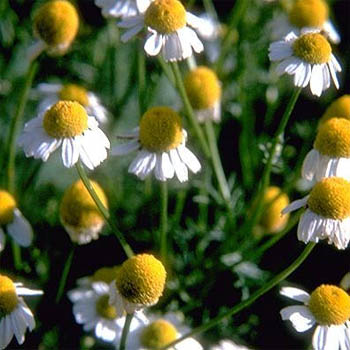
If you want to harvest flowers for making Chamomile tea, it is best to collect flowers on a sunny day (ensuring that the flowers are fully open), then dry them in the sun. Discard the stems and leaves and store the chamomile flowers in an air tight container.
German Chamomile is most often used for medicinal purposes, and is usually administered as a tea. It can also be administered as a compress for external healing and as a bath for babies. Here are a few uses:
Soothes and relaxes at bedtime.
Relieves restlessness, teething problems, and colic in children.
Relieves allergies, much as an antihistamine would.
Aids digestion when taken as a tea after meals.
Relieves morning sickness during pregnancy.
Speeds healing of skin ulcers, wounds, or burns.
Treats gastritis and ulcerative colitis.
Other Uses
Makes a relaxing bath or footbath.
Lightens fair hair and conditions complexion. Make a rinse by simmering 2 teaspoons dried flowers in 8 ounces of water for 15 minutes.
Potpourri (dry flowers face down.)
Parts of plant to use for tea: Flowers only. Taste: A rather pleasant taste, made very nice with a little bit of honey.
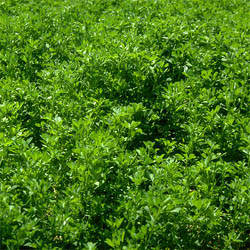

Finely chop fresh leaves into salads, white sauce for fish, fruit drinks, mayonnaise, sauerkraut, pasta, fish, chicken, pork, marinades, ice cream and herbal teas. Add to blended vinegars, try this lemon balm with tarragon. Substitute for lemon juice in jam making. Proven effective against herpes.
A strong lemon balm tea is a great substitute for lemon juice in many recipes. Quedlinburger Niederliegende is higher in essential oil content than common lemon balm, and is very productive as well. Lemon balm tea, when sweetened with honey, is used medicinally to help with stress, indigestion, and headaches.
Quedlingburger is a taller variety, up to 24 inches tall. Good oil content at about 0.2 percent. Can be grown as an annual or good outside for zones 5-9.
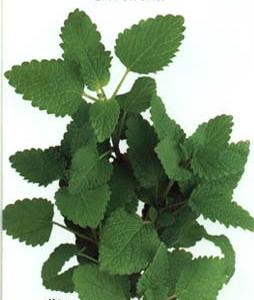
Citronella balm is a hardy perennial for Zones 5-9. It is more compact and more mildew resistant than the common lemon balm and grows 12 to 18 inches tall in ideal conditions.
The leaves are bright green and about 2 inches long with toothed edges. Although citronella balm is a member of the mint family, it is a less aggressive spreader. To the casual glance the leaves resemble spearmint leaves, probably why it's sometimes misidentified as lemon mint.
As with lemon balm, citronella balm is a favorite of bees. The botanical name "Melissa" is derived from the Greek word for bee.
Easily grown as a window sill or patio plant, it does very well in containers.
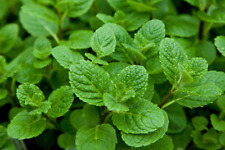
It is called applemint because the leaves when brushed give out a sweet scent that seems like a cross between spearmint and apples. The leaves have a slight fruity flavor.
Apple mint leaves are said to have certain medicinal properties. The crushed leaves of this plant are said to eliminate the pain caused by bee sting, wasp stings and other insect bites. They bring about a cooling effect on the affected part of the body.
The flowers can be used to make tea which if consumed when promotes digestion, cures many ailments such as intestine problems, stomach pain and refreshes the mind.
The Apple mint leaves also help in breaking down fat and accelerating metabolism level. The mint leaves contains nutrients like iron, potassium, calcium, vitamin A and C which replenish our body. The leaves are said to have anti-cancer properties.
Powdered leaves can be used to whiten the teeth. The essential oil extracted from the leaves is used in aromatherapy to cure acne, colic, cramp, colds, flu, stress, shock, asthma and travel sickness.
Soft gray-green round leaves are downy with a pronounced scent. One of the tallest garden mints, applemint reaches heights the other mints don't, sometimes clambering up two or more feet in height, but is best shorn down frequently to prevent bloom if the intent is to use it in cooking.
It's fuzzy leaves and stems have a distinct minty apple taste, and it lends its flavor to applemint jelly and couscous, as well as teas that will calm upset stomach and soothe body and soul. Like most mints, applemint can threaten the garden with too much of a good thing, and in its optimum growing conditions of part shade and moist soil will quickly introduce itself to neighbouring beds and lawns.
Plant it in containers, or bottomless buckets sunk into the garden bed to control its tendency to roam. Applemint is untroubled by pests in general and considered repellent of bothersome insects in the mixed border.
Keep applemint growing anywhere you want to enjoy its sweet fruity scent, and close to the kitchen to easily enjoy the wonderful flavor it adds to food.
A perennial for zones 5-9, but can be grown in containers inside just about anywhere.
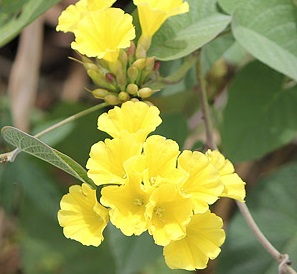
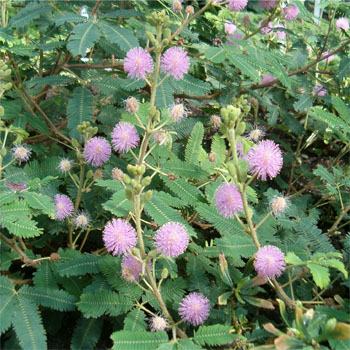
Mimosa pudica has a wide range of health benefits for issues like parasites, depression, anxiety, insomnia, and diarrhea.
Click here for a good Youtube video on the plant.

Edible Flowers: Add petals to salads, sprinkle over mild fish, use in fruit salads, or to garnish desserts and drinks. Flavor is minty and spicy.Also known as beebalm, Oswego tea, and scarlet beebalm.
Medicinal: Aerial parts in infusions to improve digestion. Leaves and blooms contain thymol-related antibiotic-antiseptic compounds. Perennial in Zones 4-9. Ht. 36-44"

Sometimes called Mint Leaf Bee Balm, this native to eastern North America and the plains, and it is easy to grow from seeds and it multiplies quickly.
It can be found naturally along riverbanks and enjoys this rich, organic, moist soil. However, it will grow in average soil as well. Full sun is best, but light shade is tolerated. Plants tend to spread more quickly in the shade. Most Monarda herbs multiply rapidly either by underground stems or freely sowing their own flower seed. In order to keep plants healthy and vigorous, they should be divided at least every three years in the spring. Deadheading spent blooms will prolong the bloom time.
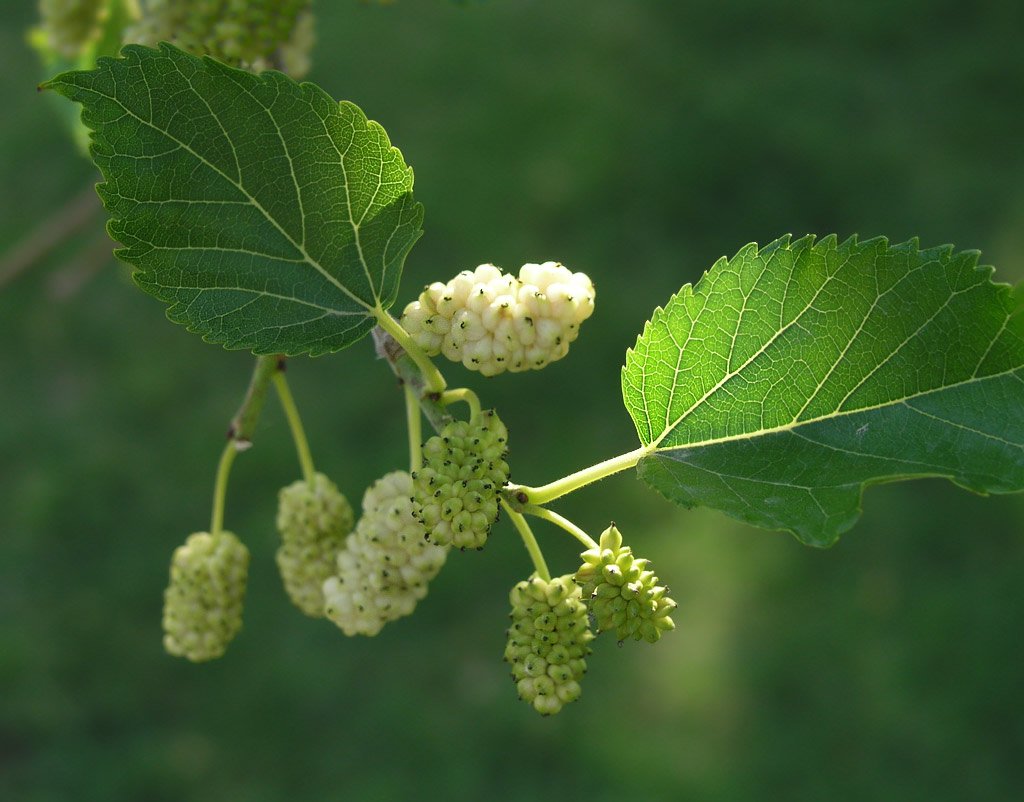
Commonly called white mulberry, this is native to China. It is a rounded, fast-growing, deciduous tree that typically grows to 30-50' tall and as wide. It usually develops a wide-spreading crown with age. The leaves of this tree have been used in China since at least 2600 B.C. as the primary diet for silkworms used to make silk. Trees were introduced into North America in colonial times in an effort to establish a silk industry. Although the industry never took hold, the trees did take hold and have over time escaped cultivation and naturalized in fields, waste areas, forest margins and along roads throughout much of the U.S.
This tree has also been planted in various areas for erosion control and windbreaks. White mulberry is usually dioecious (separate male and female trees), but sometimes is monoecious. Small yellowish-green flowers in drooping catkins bloom in spring (March-April). Fertilized flowers on female trees are followed by sweet, edible blackberry-like fruits (cylindrical drupes to 1" long) that mature in June. Fruits ripen to white or pink, but sometimes to darker reds or purple-blacks. Fruits are loved by birds.
Best suited for zones 4-9.
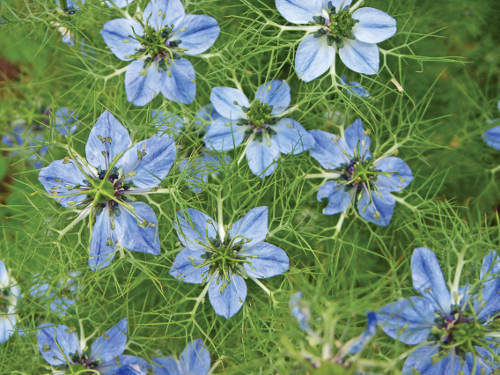
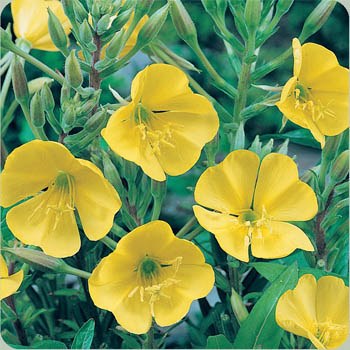
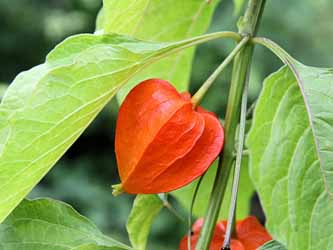
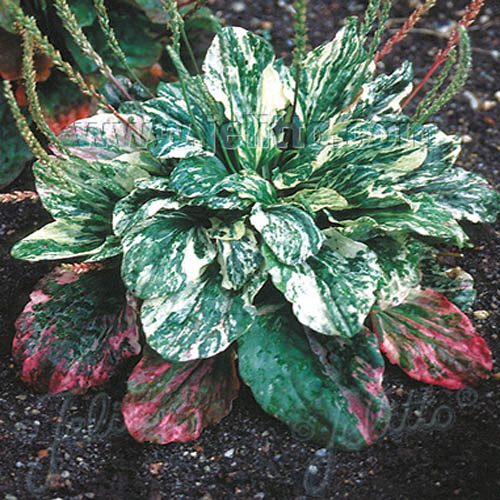
For millennia, poultices of plantain leaves have been applied to wounds, sores, and stings to promote healing.
A hardy perennial for zones 3-9.
Basic Seedsowing Info:
Sow inside at 68 degrees, if no germination in 3 to 4 weeks, move to 24-39 degrees ( fridge ) for 2-4 weeks. Average Germ Time: 21-28 days. Light required to germinate. Cover 1/16 inch. Keep seeds moist until germination.
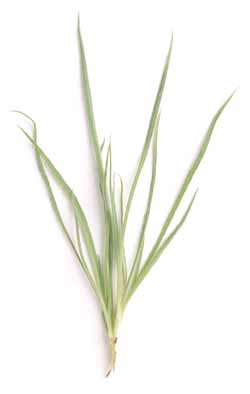
A low growing annual with soft, grass like, hairy leaves. The famous Metamucil laxative is made from the seeds. Used in remedies for constipation and bowel problems.
Mucilaginous seed coats, lubricate and cleanse the intestines, also acting as a mild laxative.
Seed has property of mucilage formation on extraction of moisture.
Psyllium seeds are cooling, laxative, soothing, antiacidic, anti diuretic and demulcent.
Grows well in almost any garden soil.
Industrially used as basic stabilizer in ice-cream, sizing in chocolate, seed mucilage are also used in cosmetics.
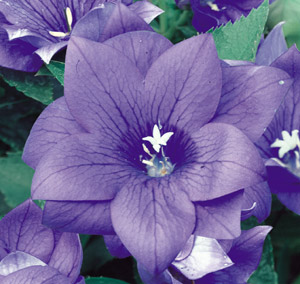
Double violet blue flowers, upright stems, summer, sun, great for cutting material, grows about 36" tall, perennial hardy to zone 3.
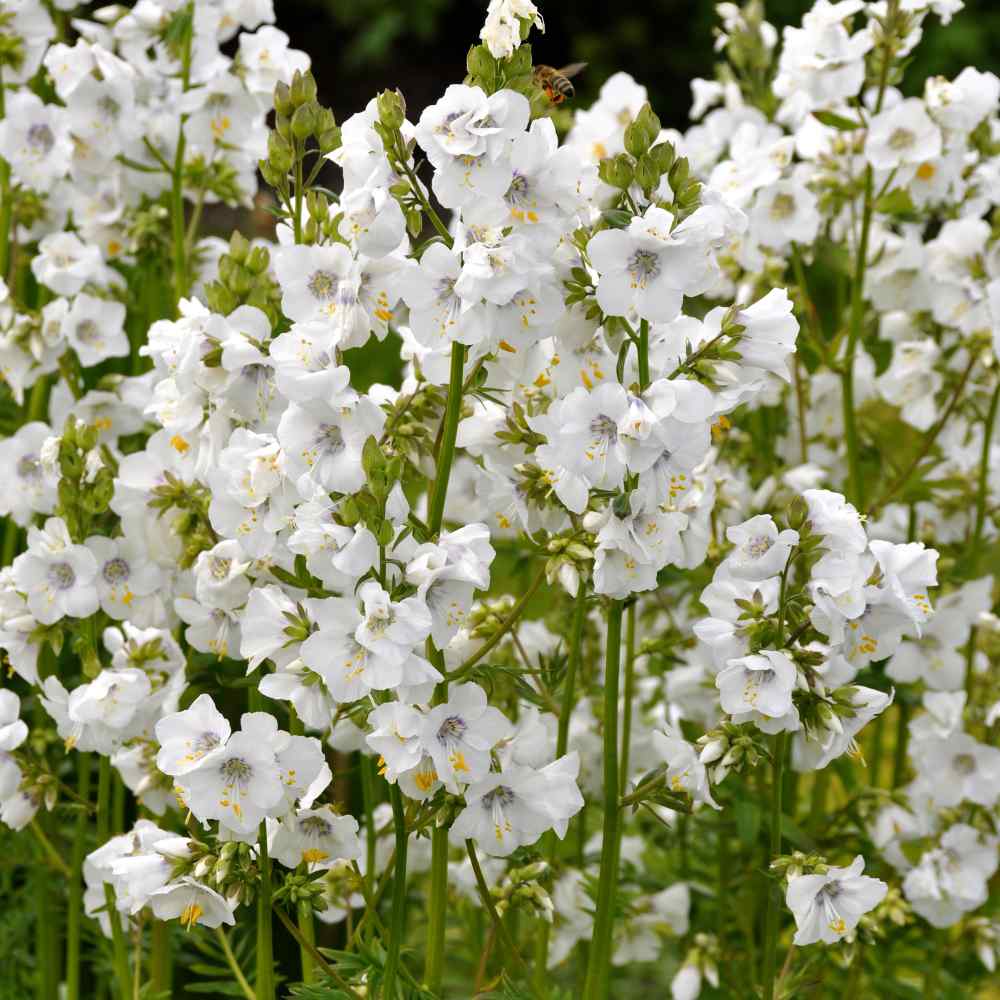
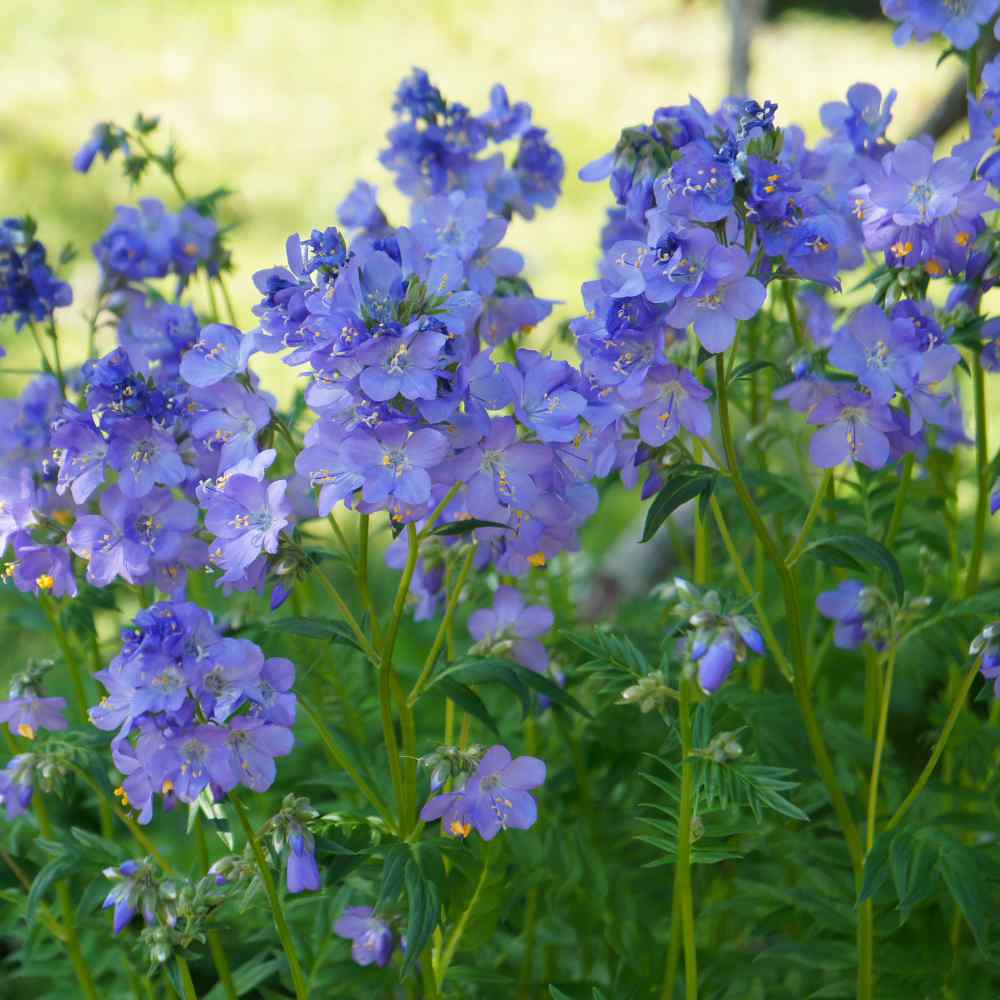
Jacob's Ladder requires good soil drainage as well as full sun to partial shade. The foliage blends well with hostas, bleeding hearts and lilies. Many people believe that the Jacob's Ladder herb can be used for a remedy for headaches, nervousness, and heart irregularities. More research is needed in this area. A perennial for zones 3-8.
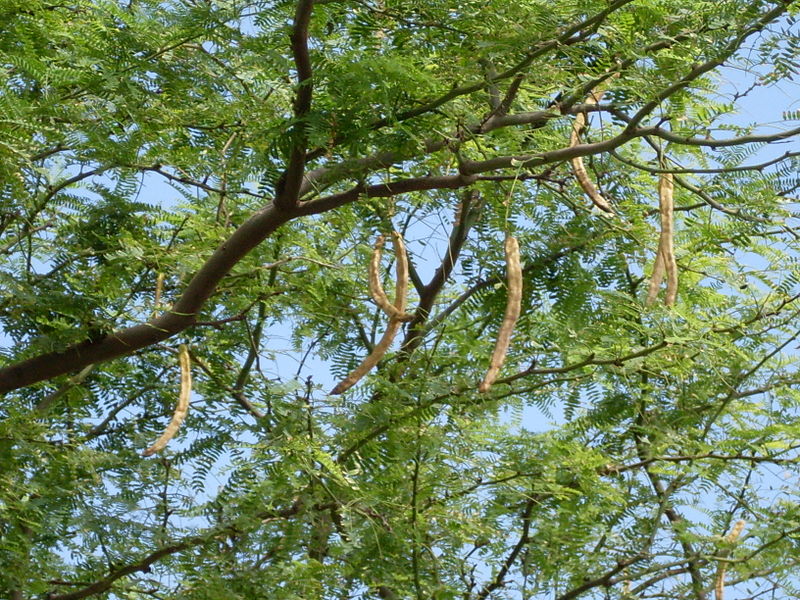
The leaves can be used for forage. Providing good bee pasturage also, nectar from mesquite yields a superior honey. The wood is used for parquet floors, furniture, and turnery items, fencepost, pilings, as a substrate for producing single-cell protein, but most of all for fuel. Toasted seeds are added to coffee.
Bark, rich in tannin, is used for roofing in Colombia. The gum forms an adhesive mucilage, used as an emulsifying agent. Gum is used in confectionary and mending pottery. Roots contain 6-7% tannin, which might discourage Rhizobia. It is valued for wood and often used for cooking. It displays yellow blossoms and bean pods that are valuable to wildlife. Tool handles, plaque wood, fenceposts and aromatic charcoal for barbecuing are made from mesquite. Despite its sweetness, mesquite flour which is produced by grinding whole pods, has been found in medicinal research to be extremely effective in controlling blood sugar levels in people with diabetes. This is an excellent desert species for low-maintenance desert windbreaks and re-vegetation. Growth rate is faster when supplemental water is used.
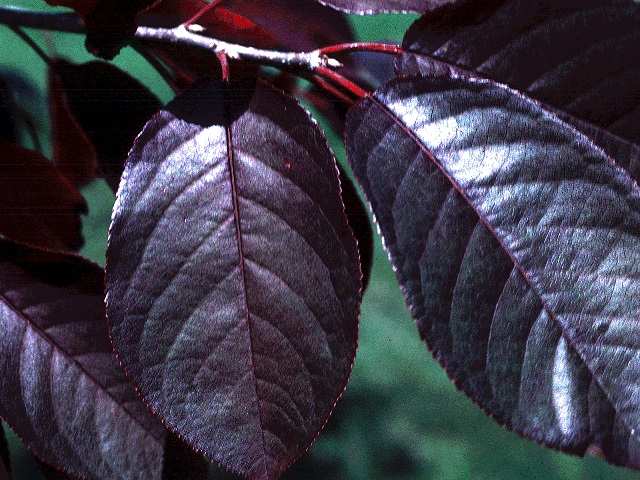
This deciduous plant is a great addition to any garden as it attracts birds and butterflies and can be used as a specimen, shrub border, or informal hedge. It is fairly adaptable; it can thrive in full sun or part shade and in dry to medium moisture, well-drained soils. Shubert Chokecherry is also rich in antioxidant pigment compounds and can be used to make delicious jams, jellies, or syrups. Grow the Schubert Chokecherry in your garden and enjoy its stunning beauty and tasty fruit!
Grows well in zones 2-7.
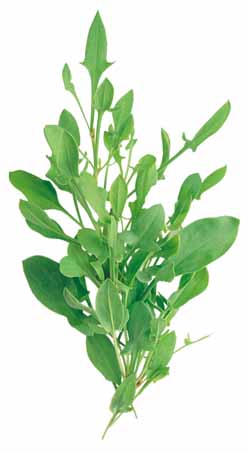
One of 4 ingredients in the Essiac® anti-cancer formula.
Sheep sorrel is an herb that many Americans consider to be just a common weed, particularly in areas where blueberries grown. However, its medicinal uses have been known for quite some time. In fact, it has recently received extra attention for its use in a common cancer tea.
Historically, sheep sorrel has been used to treat a variety of issues from inflammation and diarrhea to scurvy and cancer. What's interesting about this herb is that every single part of the plant can be used medicinally.
Sheep sorrel differs from the common garden sorrel, it's leaves being smaller, more pointed and taking longer to collect.
The sheep sorrel herb has been considered a rich source of vitamin C, E, beta-carotene, and other carotenoids.
A perennial hardy in zones 4-8.
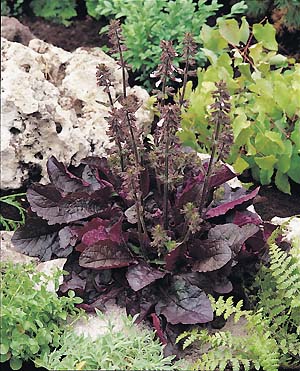
Hardy in zones 5-8, perennial.
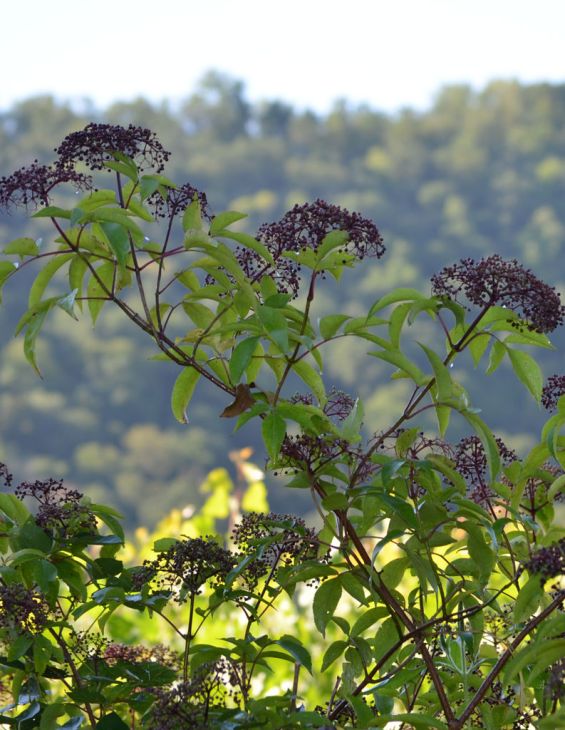
According to WebMD, the berries and flowers of elderberry are packed with antioxidants and vitamins that may boost your immune system. They could help tame inflammation, lessen stress, and help protect your heart, too. Some experts recommend elderberry to help prevent and ease cold and flu symptoms. It’s also been used as a treatment for: Constipation, joint and muscle pain, infections that affect how you breathe, headaches, fever, kidney problems, epilepsy, minor skin conditions, stress, HIV and AIDS
It is closely related to the European Sambucus nigra. Some authors treat it as conspecific, under the name Sambucus nigra subsp. canadensis. The primary difference is the European variety is more tree like, where the American variety is more shrublike, the flowers, fruits and uses are almost identical. Some authorities consider this plant to be a subspecies or variety of Sambucus nigra instead of a separate species.
Elderberry erupts with large, lacey sprays of white blossom clusters in June. As the flowers continue to bloom, they fill in to create large umbels and exude a delicate citrusy fragrance, inviting myriads of little pollinators to come visit. Flowers are replaced by succulent, burgundy berries that darken to a rich black-purple once they are ripe. Bowed branches drape and 'water fountain' from the center, providing dense shelter for nesting birds. The foliage turns a lovely burnished yellow in the fall. Various studies reported in food and horticulture scientific journals report that American elderberry as well as the European elder contain antioxidants and have anti-inflammatory and anti-viral properties. According to the USDA, raw elderberry juice is a good source of iron and potassium and vitamins A, B6 and C.
Elderberry plants are easy to grow and can be grown from cuttings or potted plants. They prefer moist, fertile soil and full sun, but can tolerate partial shade and some drought. They can be grown in zones 3-9.
Seeds need 60 days cold stratification before sowing.
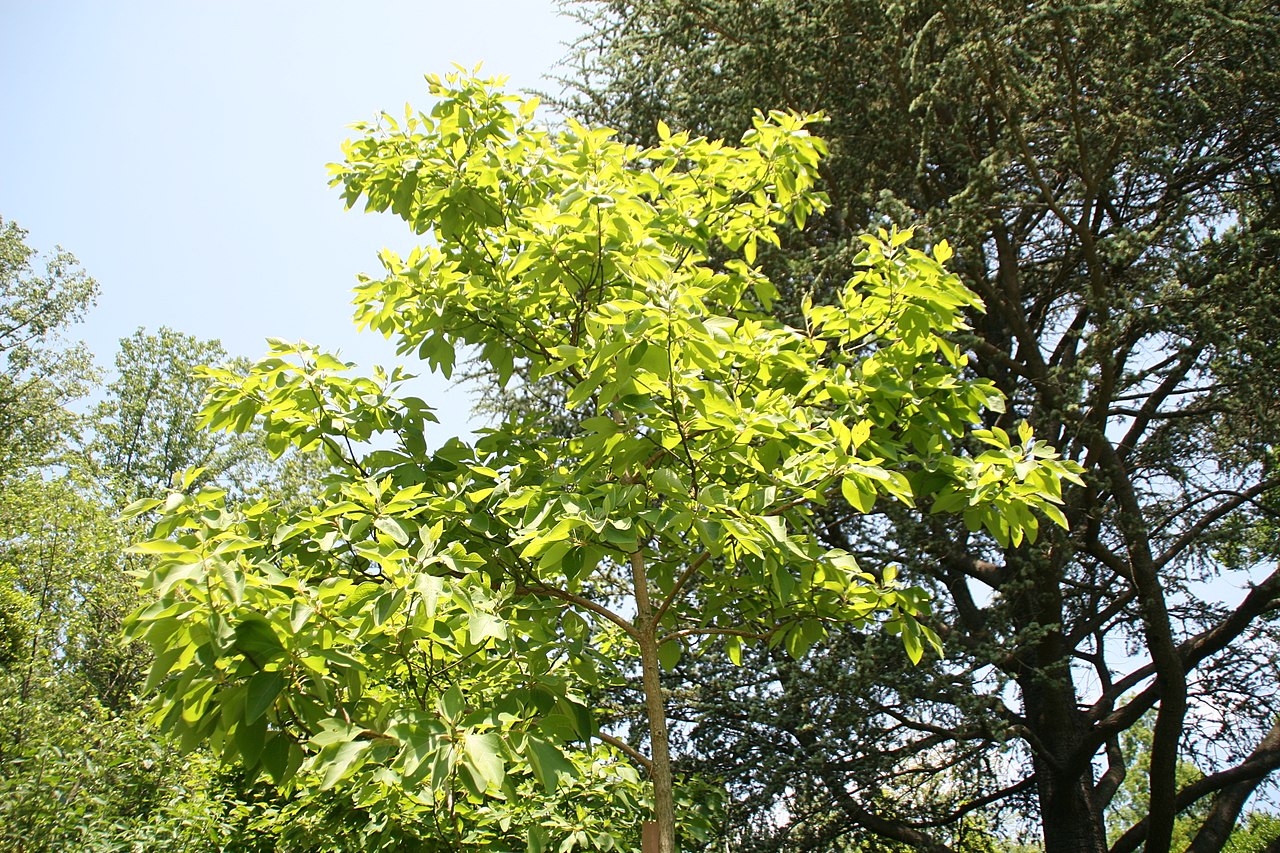
Sassafras boasts small, fragrant yellow flowers and dark blue fruits that sit on a bright red stalk—an enticing treat for birds. The roots and leaves have been traditionally used in tea-making and even soups due to their aromatic and spicy qualities. Sassafras is valued beyond its aesthetic appeal. It has roots in medicinal use, primarily for pain relief and dental hygiene, due to its essential oil, aptly named Sassafras oil. Its root bark has also been used to extract acids for perfume manufacturing.
The wood of Sassafras, a durable, deep orange-brown, was once used for various needs such as posts, rails, and small boats. Today, it’s often admired as a distinctive choice for furniture.
With all these wide-ranging benefits and delightful features, it's easy to see why Sassafras albidum is loved by many.
Excellent for naturalized plantings or screens where they are given lots of space to colonize. Also can be grown as lawn specimens. Zones 4-9.

It has edible flowers, which have a spicy and citrus-like flavor, can be used as a garnish on ice cream and drinks.
Commonly known as toothache plant. Contains a natural analgesic which numbs the tongue and gums, relieving toothache pain. This numbing sensation arises from chewing either the flowers or leaves.
The full, mounding habit is perfect for containers and bed plantings. Heat tolerant.
A fast growing annual plant reaching 12-15 inches tall in about 90-100 days.
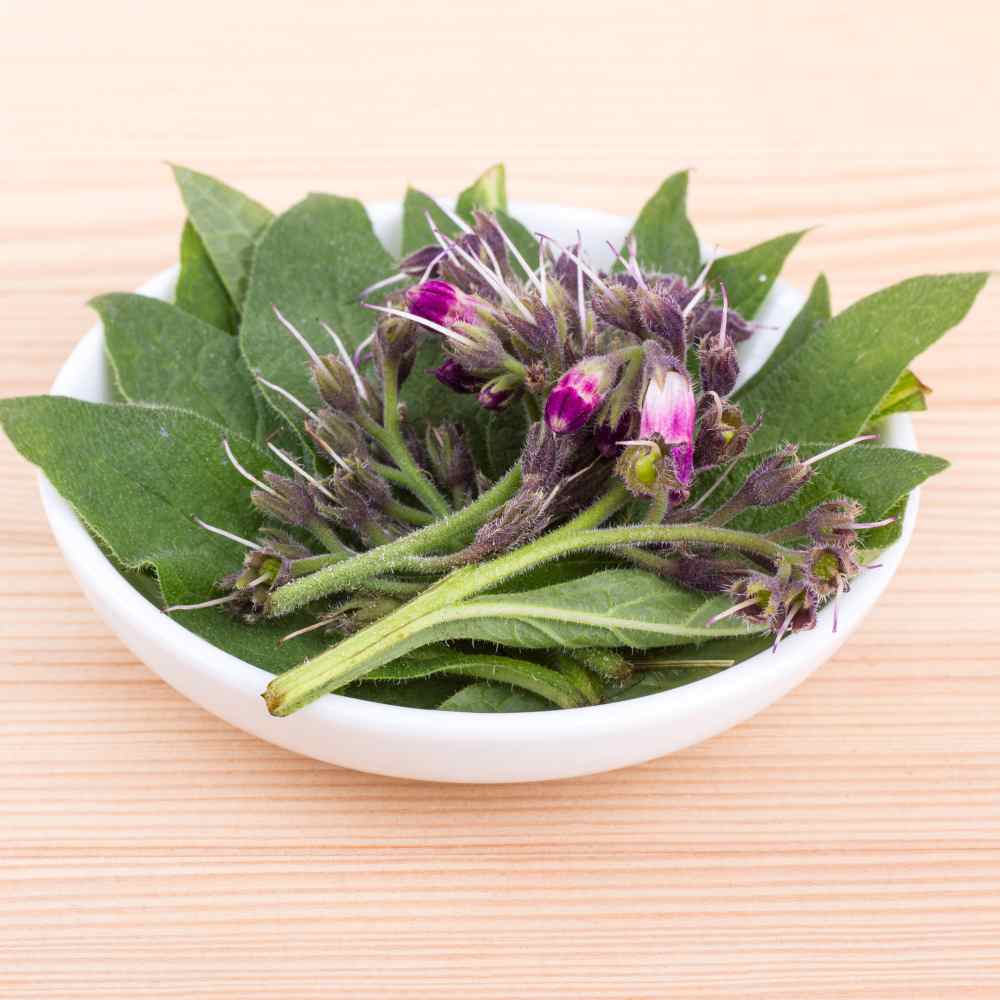
Comfrey contains chemicals that speed up wound healing. It has astringent, antifungal and antibacterial properties. Comfrey also contains a wide variety of healthy chemicals and nutrients. It has been recently learned that it can be a carcinogenic when taken internally, but it is still used as a topical treatment for skin irritations, cuts, sprains and swelling.
The form and size of the Comfrey herb might have you thinking it is a shrub, but it will die back to the ground in the winter and it does not get woody. Comfrey has a deep tap root, so it is extremely drought tolerant and a useful clay busting plant. It is also useful as a slug and snail repellent.
Leaves can be harvested and dried at any time. If you are growing it to harvest the leaves, you can make your first cutting when the plants are about 2 feet tall. Cut back to within a few inches of the crow. If you begin harvesting early, you won't get flowers. Leaves, flowers and roots have all been used in traditional medicine, but use extreme caution if you don't know what you're doing. Comfrey should never be taken orally and even a topical application can cause problems.
Comfrey is a beautiful addition to any border and is great for grabbing attention to the back of a border. Comfrey's tall height makes it a perfect candidate to grow around trees in an orchard. As a nutrient accumulator, comfrey mines the subsoil for nutrients (potassium, phosphorus, calcium, and more).
Perfect for permacultures. Attracts pollinators. Provides habitat for beneficial insects. Fertilizes with nutrient-rich mulch. A perennila for zones 4-9.
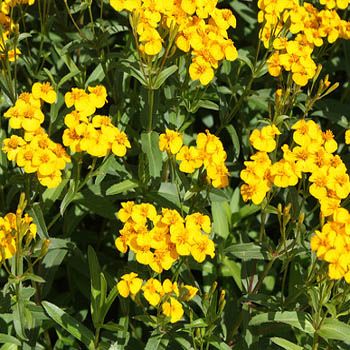
Although not in the same genus as the other tarragons, winter tarragon has a stronger flavor than Russian tarragon that does not diminish significantly with age.
Growing to 3 or 4 feet, Tagetes lucida is handsome in the garden and may be cut for use all summer and fall. Even if left untrimmed, the leaves remain usable and fresh throughout the growing season.
Try growing winter tarragon in an herb garden, flower bed, or container. Let it be the bright spot in your herb garden, which often needs a boost by summer's end. The upright plants pair well with other fall bloomers such as pineapple sage. Plants bloom lightly in the spring, then profusely in the fall.
Hardy to at least 5 degrees, and very easy to grow.
Medicinal: Stimulant and diuretic. Improves digestion. 80-90 days to harvest when started indoors.
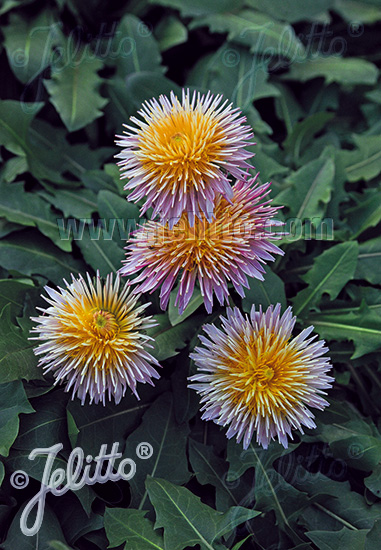
If you are growing dandelions, why not grow this unique, decorative variety that can be used as a medicinal plant, culinary herb, groundcover or as a honey-bee food plant. A perennial plant for zones 3-8.
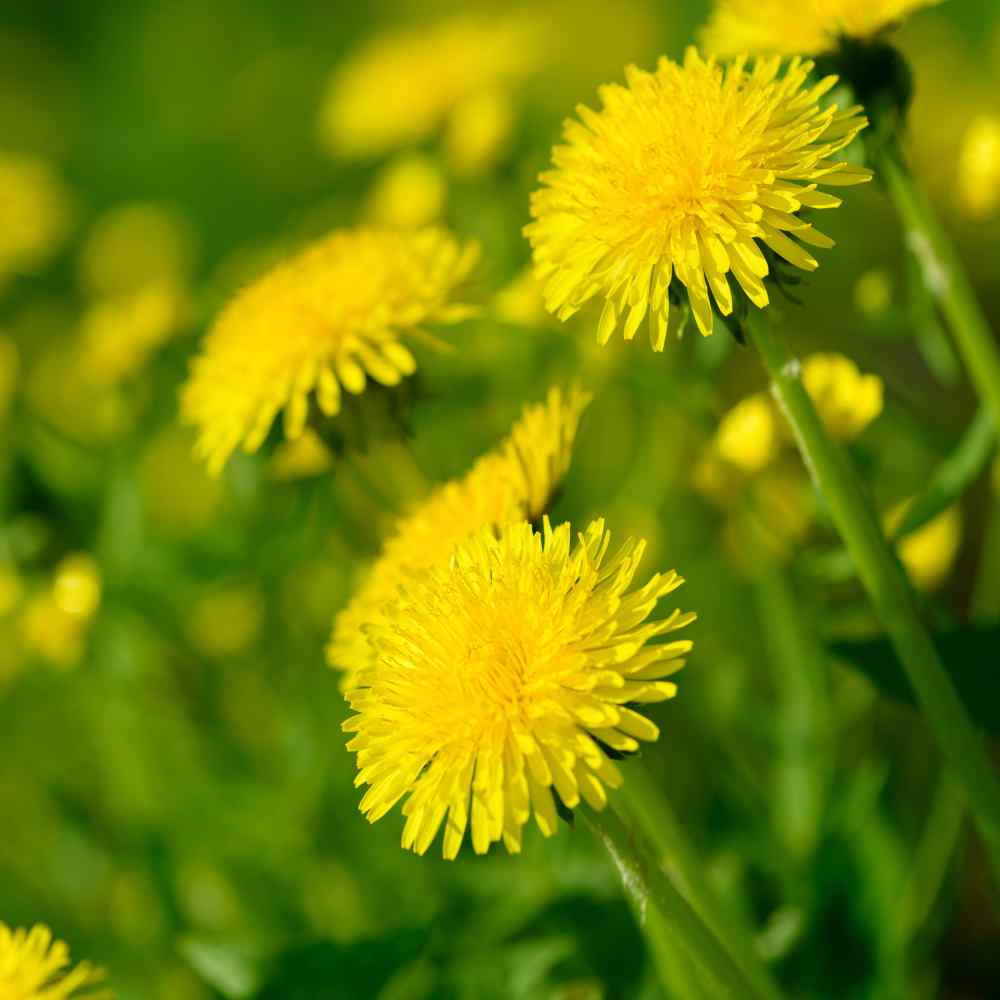
Dandelion herbs are a widely used in the kitchen. The leaves are best when they are tender in the spring and again in the fall. They are packed with nutrients like vitamins, beta-carotene, iron and other minerals. Dandelion leaves are often added to tossed salads and the taste is very complementary to other greens. The leaves can also be steamed or sauteed with other vegetables for a side dish. The flowers are used in wine making, and the taproot is edible as well. A perennial plant for zones 3-8.

It has bright green opposite leaves, 2-3 inches long with sharply toothed edges. The smooth squarish twigs are green, turning tan or reddish tan as they age. The bark on the main trunk is light brown and becomes corky with age.
The 1-2 inch sunshine yellow flowers are trumpet shaped. They hang in showy clusters at the branch tips and forks, bending the twigs into arches with their weight. There are two folds along the bottom of the flower's throat and several delicate rust-red lines decorating the interior. The blooms appear in flushes throughout the growing season.
They are followed by 4-8 inch long stringbean-like pods that hang in vertical clusters. These turn brown and split open to release flat oblong 1/4 inch seeds with transparent 1/4 inch wings on each end.
Common yellow elder is a Central and South American tree that grows to 25 ft. It has bright yellow flowers and dense, lushly green foliage that is evergreen in tropical climates, but deciduous in chillier places.
Yellow elder will grow on a wide variety of soils, including sand and limerock. The plants can be cut to the ground for rejuvenation in the early spring or carefully sheared during the growing season to control shape and size and promote new flushes of flowers.
This species needs full sun. Yellow elder likes well drained soil. Potted plants should be given minimal water when not in active growth. Hardiness: USDA Zones 7 - 11. Freeze tolerance varies dramatically, with some forms able to survive temperatures down to around 10 degrees and others severely injured by only a few degrees of frost.
Yellow elder is typically deciduous and may freeze back or have a rather awkward shape, so it is best set among more consistent shrubs where it can contribute color to a border or screen. The yellow blooms are spectacular behind blue agave. Since this species drops its abundant blossoms before they wither, it can advantageously be placed where the fallen blossoms will form a pool of gold on the ground. Nurserymen say yellow elder sells best when marketed as a flowering shrub in a 1-3 gal pot and promoted as a tropical patio plant.
Yellow elder has been used for a variety of purposes in herbal medicine. Its primary applications have been in treating diabetes and digestive problems. Extracts from Tecoma stans leaves have been found to inhibit the growth of the yeast infection, Candida albicans. Yellow elder also contains several compounds noted for their catnip-like effects on felines.
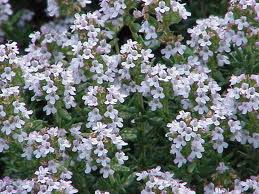
It even makes a pretty patch of small ground cover. Growing thyme provides an anchor in an herb garden in areas where it is evergreen in winter. Thyme is also perfect for containers, either alone or in combination with plants that won't shade it out.
It is not only attractive in the perennial border or herb garden, but it also attracts birds, bees and butterflies to the garden as well. It is also commonly referred to as Garden Thyme or English Thyme.
This variety is often planted near vegetables to help control flea beetles and several cabbage pests.
A perennial for zones 4-9.

It has been used since ancient times to achieve healing, cure chest congestion, and induce saliva; the fresh leaves are taken to relieve sore throats. The plant is also used as an effective remedy for chest infections (bronchitis, pharyngitis, whooping cough) as well as to treat worms in children.
The plant has been used for its flavor in cooking. Thymus vulgaris essential oil is used as an antiseptic, antiviral, and antimicrobial agent in folk medicine. Thyme also possesses carminative and antioxidative effects. Grow as an annual in zones colder than 6.
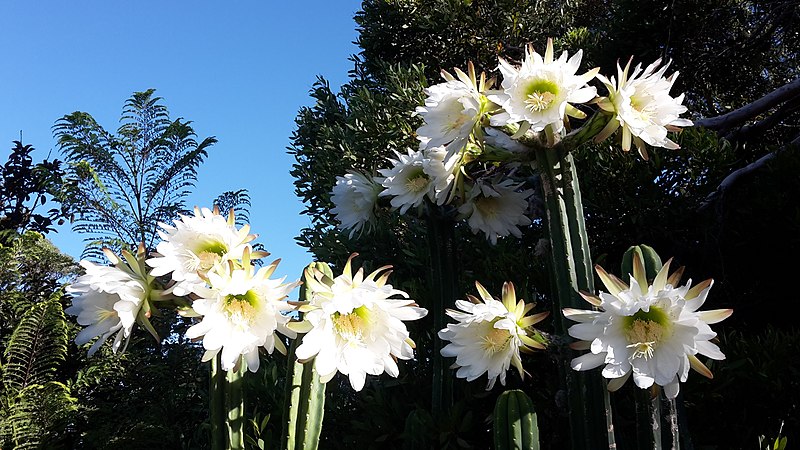
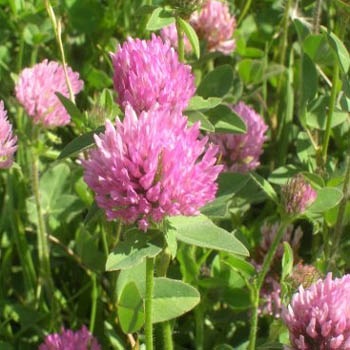
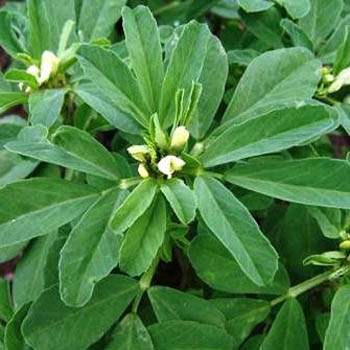
A decoction
made from the seeds is give to strengthen those suffering from
tuberculosis or recovering from an illness. Also used as an
aphrodisiac. As a poultice, it has many uses.
Parts of plant to use for tea: Seeds and Leaves Taste: A rather
pleasant taste, although slightly bitter.
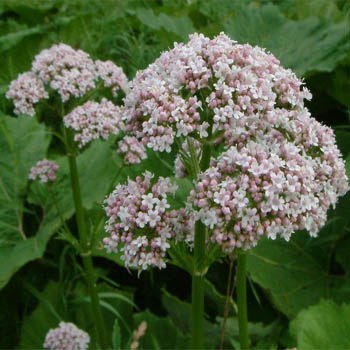
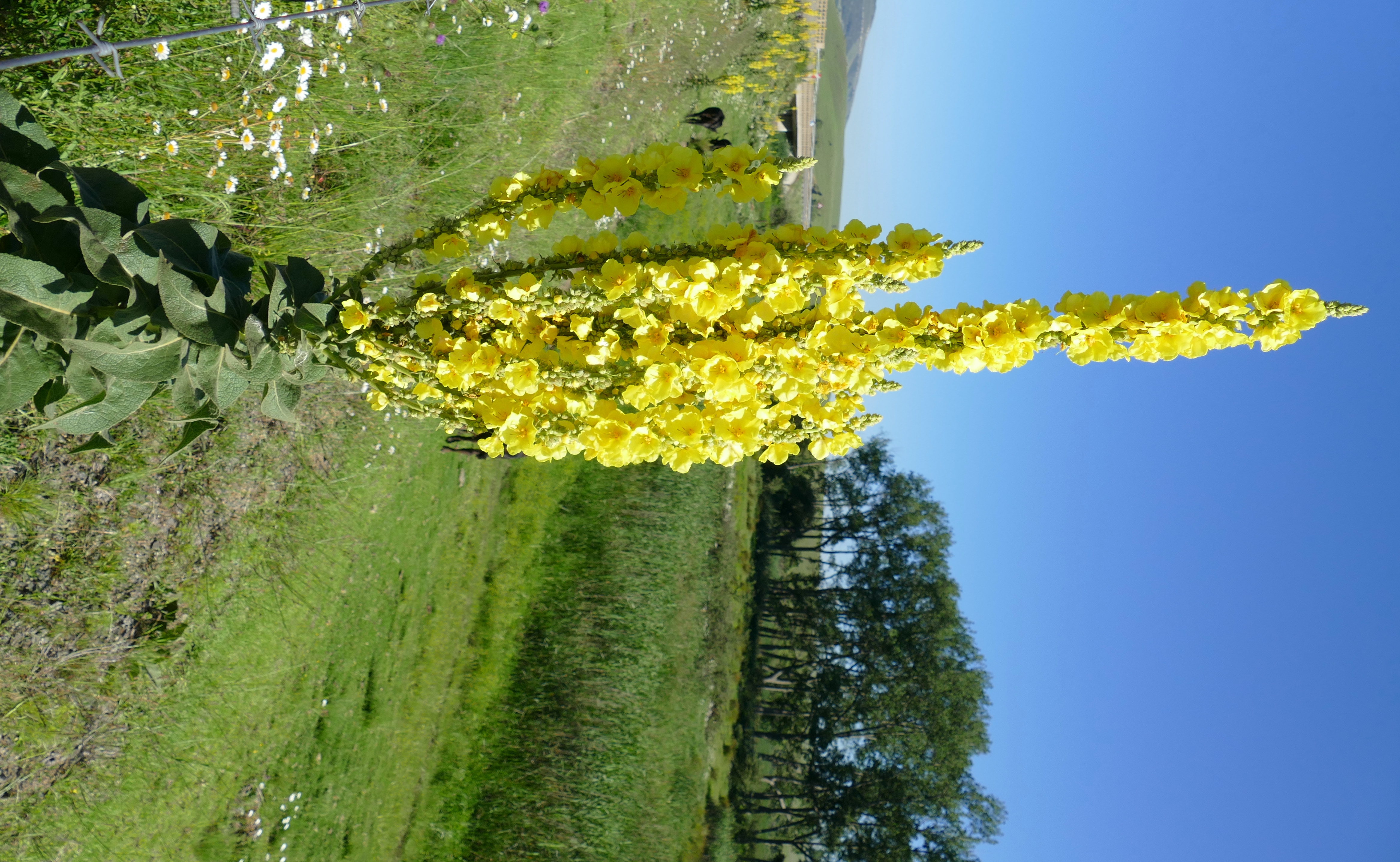
It is a spectacular tall plant great as a border backdrop or in a naturalized setting. Attracts bee's and butterflies has well known medicinal properties. Flowers early spring through late summer Cannot ship to CO, HI, SD
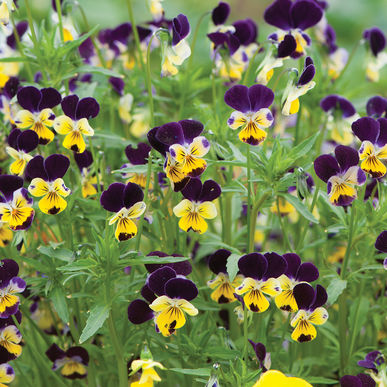
These are also a wonderful selection for parts of your flower beds with poor soil, as they will grow just about anywhere. A compact annual or perennial, these will re-seed easily if given the chance. This variety has been used extensively in floral gardens and has escaped from cultivation to roadsides, fields and waste areas throughout much of the United States.
The vibrant blooms are deep purple and yellow, creating a solid carpet of color for weeks. Prefers partial shade to full sun in rich, well drained soil.
Was once a potent symbol of romance for courting couples. Used for dropsy, respiratory catarrh and skin eruptions. Flowers are edible.

